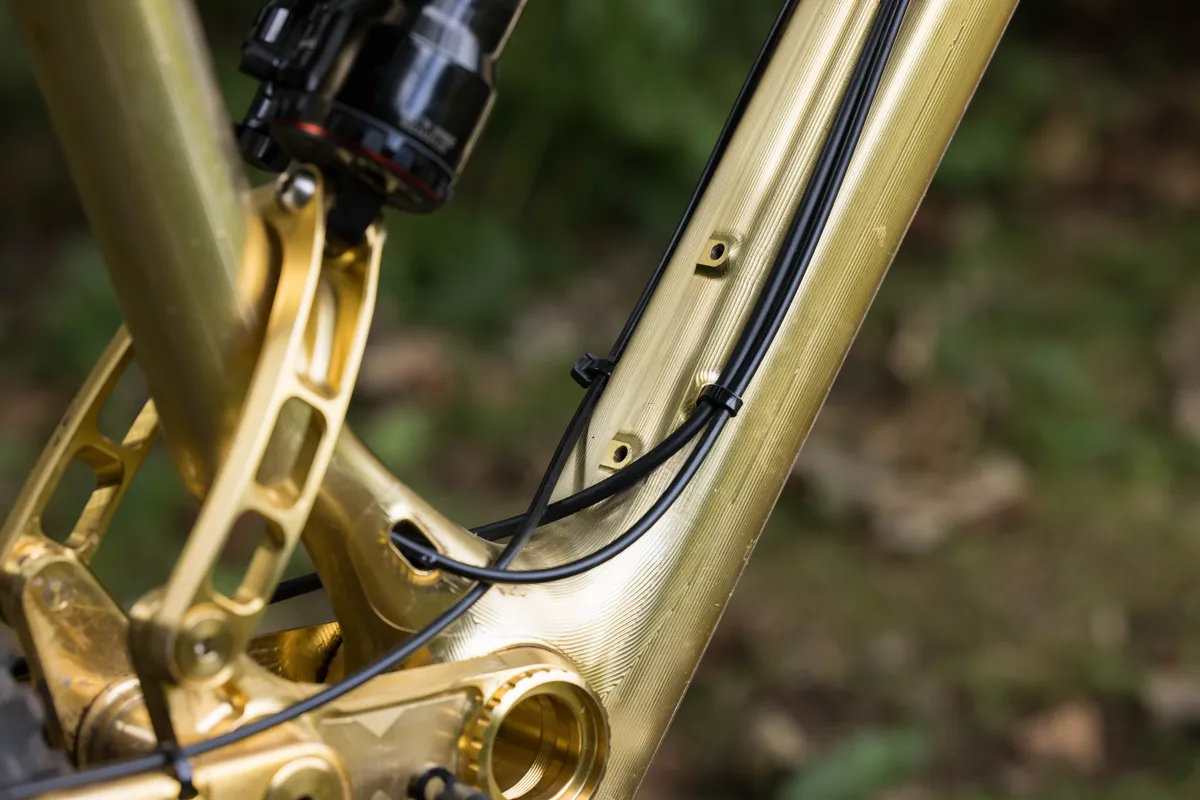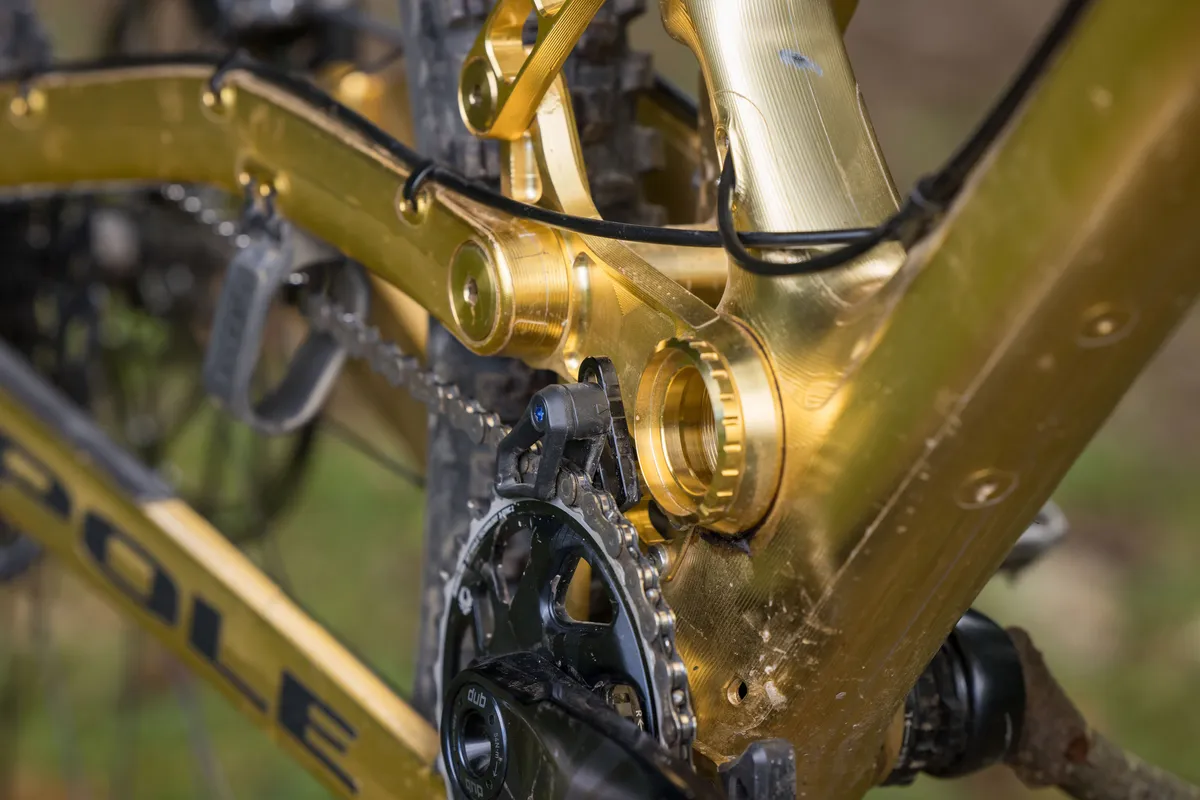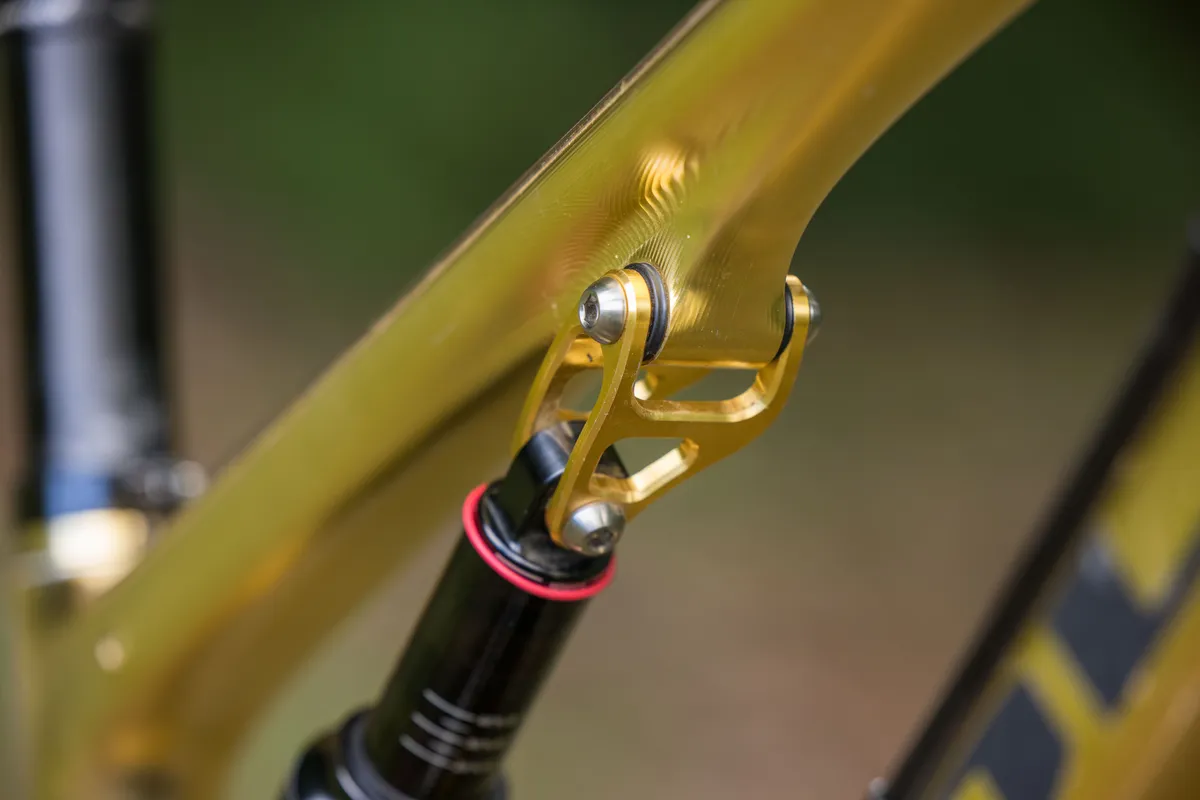Pole’s Stamina 160 Remastered is the Finnish brand's mid-travel trail-come-enduro bike that is designed to be "the most modifiable frame in the Stamina range" – this impressive bike boasts not only adjustable travel (by swapping out the shock yoke, transforming it to become identical to the Stamina 180), but it is also compatible with both 29in wheels front and back and a mullet 27.5in rear, 29in front setup.
True to Pole’s design ethos, the Stamina 160 Remastered is adorned with the brand’s modern geometry, truly taking progressive figures to the next level with the second biggest bike (of a four-size range) sporting a lengthy 480mm reach figure.
The K2 size I tested is designed for riders from between 170cm and 185cm depending on riding style; Pole says it’ll be more suited to taller playful riders or shorter riders who are looking for outright speed. The smallest available size Stamina has a 450mm reach and Pole claims that it's suitable for riders between 160cm and 175cm tall.
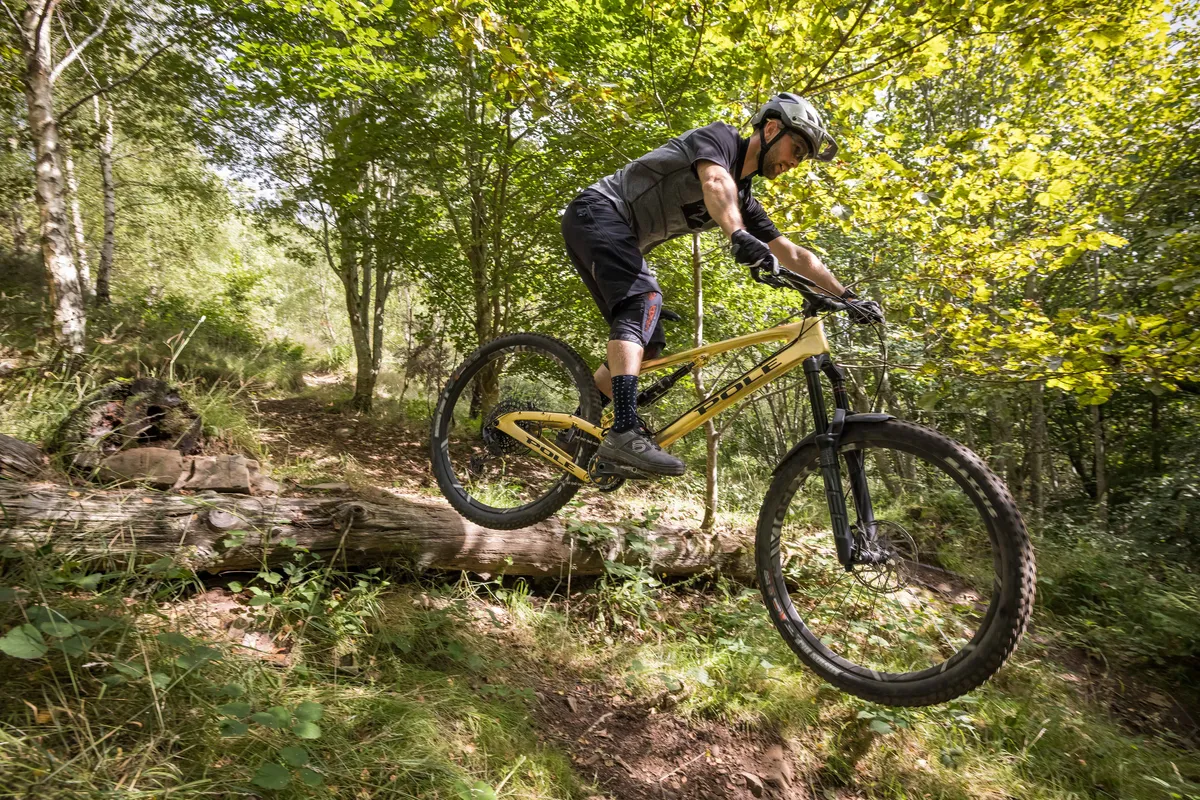
It would be remiss of me to not mention the brand’s frame construction technique in the introduction. Eagle-eyed readers or bike fanatics will know why the Stamina’s fabrication is so special, but for the uninitiated, Pole CNC machines their frame's monocoque parts from 7075-T6 aluminium, then bonds the two main frame halves together with glue. This, the brand claims, makes them stronger and lighter than welded alternatives.
Finally, the gold electrophoretic clear coat finish looks unique. Obtaining this finish requires the frame to be dipped in a special solution where an electrical current is passed through it, causing the solution to attach to the surface of the frame. Although it’s not the same as anodising, the process is similar and the result is impressive.
How does the Stamina ride?
The Stamina 160 Remastered is an outrageously fast bike to ride on all terrain types from the chunkiest rock gardens, steepest single tracks to the smoothest flow trails. Don’t let the long, slack, and low geometry put you off, it’s no slouch even when gradients flatten.
Despite some difficulties getting the suspension setup correctly, and a headache caused by the EXO casing tyres and Huck Norris tyre inserts, the Stamina is an impressive bike worthy of your attention especially if you’re in the market for a boutique enduro racer.
Click to skip to my detailed ride impressions.
Pole Stamina 160 Remastered frame and suspension details
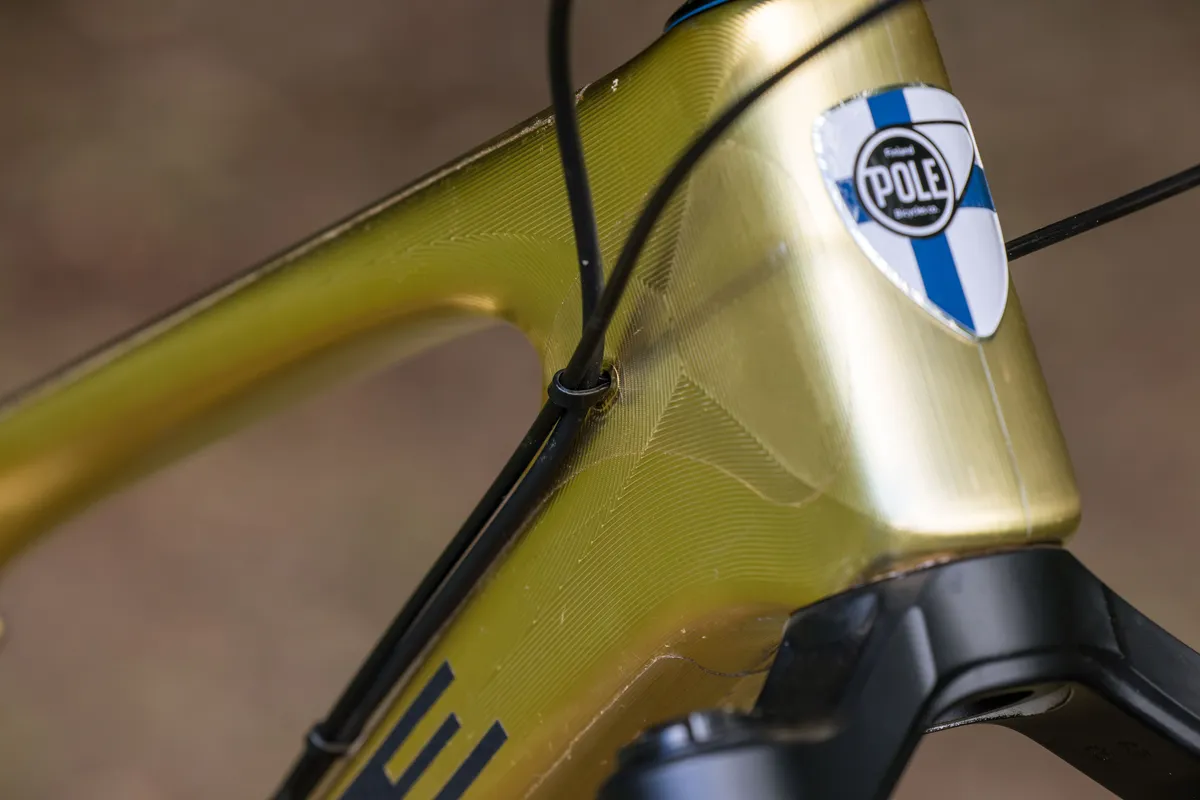
The Stamina 160 Remastered’s looks certainly set it apart from the competition, and not only because of its gold colour (it’s also available in a clear light silver colour and a dark grey should the gold not be to your taste).
The bonkers-looking machined construction, where the metal’s finish has lines from the machining process, means each half of the Stamina’s is bonded together and then cured.
The brand extols the strength of its machined and glued 7075-T6 aluminium construction, claiming it is stronger than 6061-T6, 7005-T6, and 7020-T6 aluminium in terms of fatigue, shear and tensile strengths.
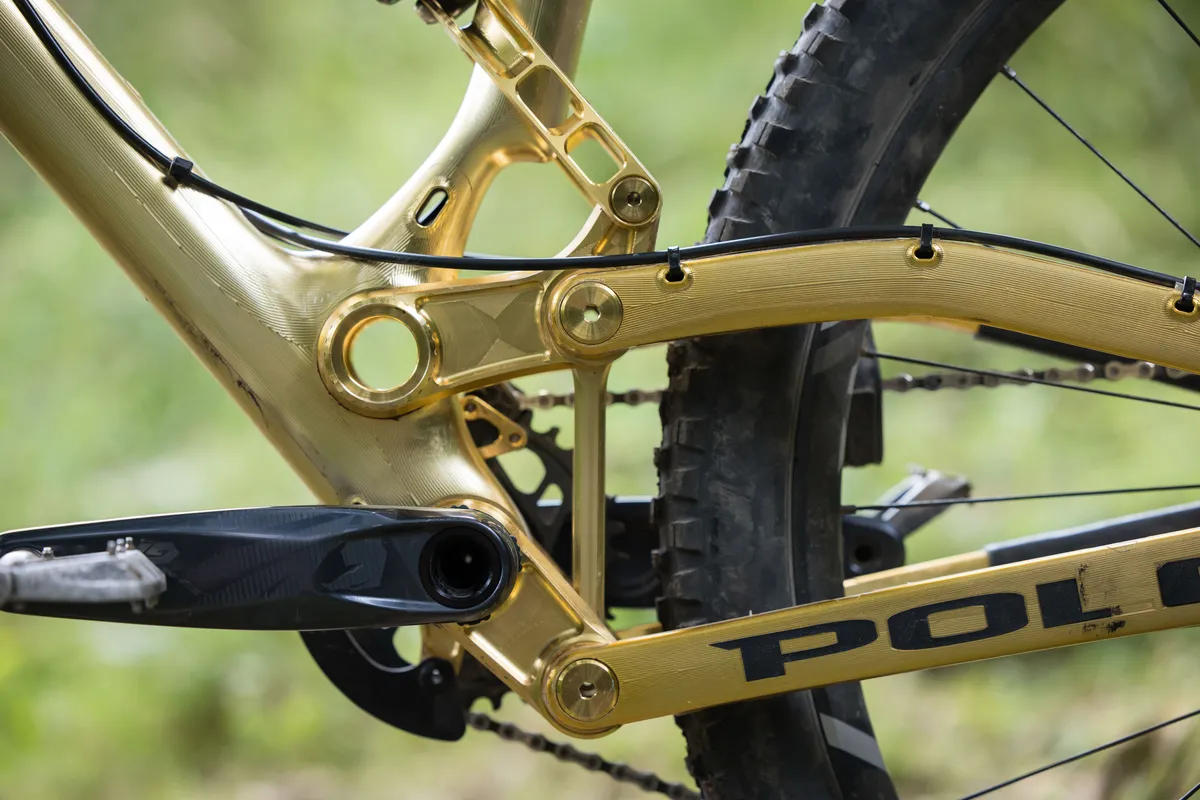
To back this up, Pole’s put the Stamina through the rigorous EFBE Gravity Cat-5 tests, where it was awarded the EFBE TRI-TEST seal for passing with 'flying colours' according to the test centre.
The Stamina’s overall shape also sparks intrigue. The low-slung rear end, intricate-looking linkage and clean but bold front end certainly make it stand out.
Of course, the practical reasons for the shape of the front triangle include plenty of space for three water bottle mounts – there are two inside the front triangle and one on the underside of the downtube – and space for externally-routed cables, along with how it looks after applying their forward-thinking geometry in reality.
The Stamina’s frame is specced with all the usual bits and bobs, including a 73mm BSA threaded bottom bracket, a post-mount rear brake, a 230x65mm metric – but not trunnion – rear shock and a 34.9mm seat tube diameter.
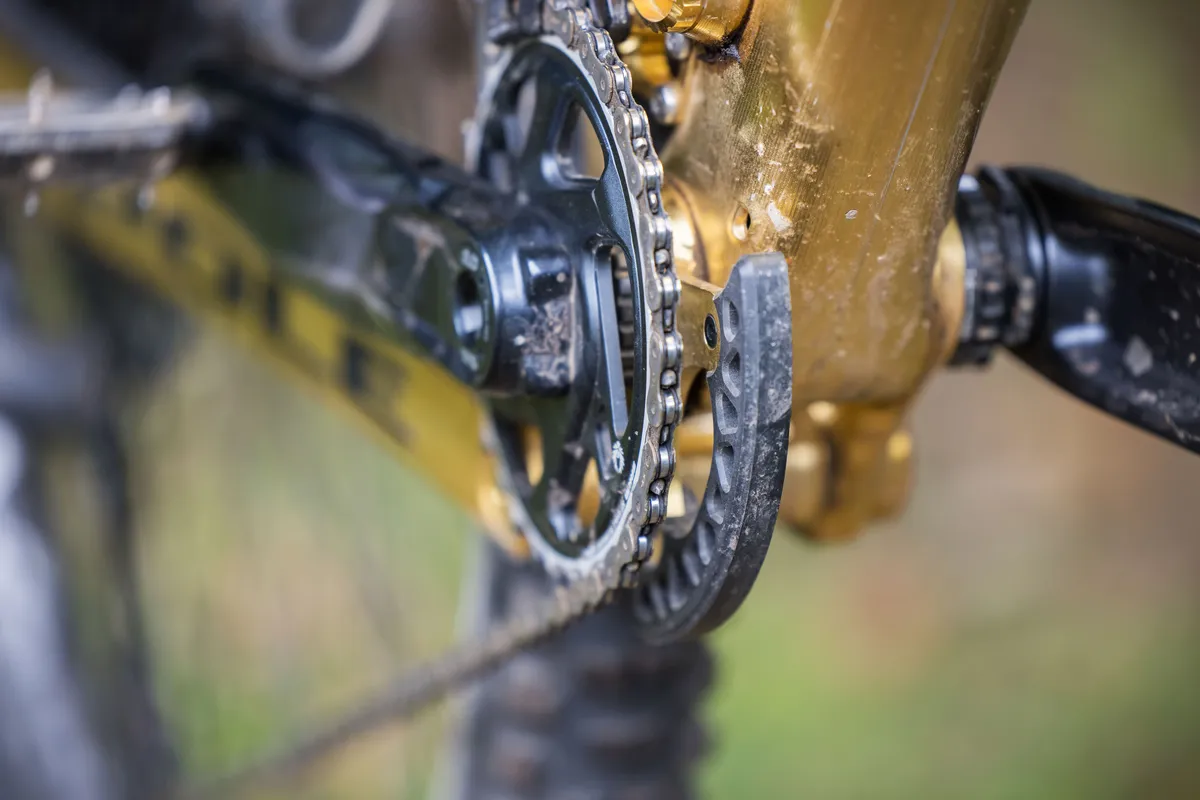
It also has in-built ISCG tabs for Pole’s own bash guard that’s supplied with the frame.
The swingarm has plenty of clearance for larger tyres and Pole are using SRAM’s Universal Derailleur Hanger (UDH) instead of its own proprietary system. There are also zip tie holes for the supplied STFU’s drivetrain damper on the drive-side seat stay.
This is all topped off with 160mm of rear wheel travel, controlled by Pole’s Dogbone swingarm. The suspension has two co-rating links, one coupling the swing arm and main frame concentrically to the bottom bracket, the other just above the chainring, that are joined together by a separate linkage. The upper main link then drives the rear shock via a yoke.
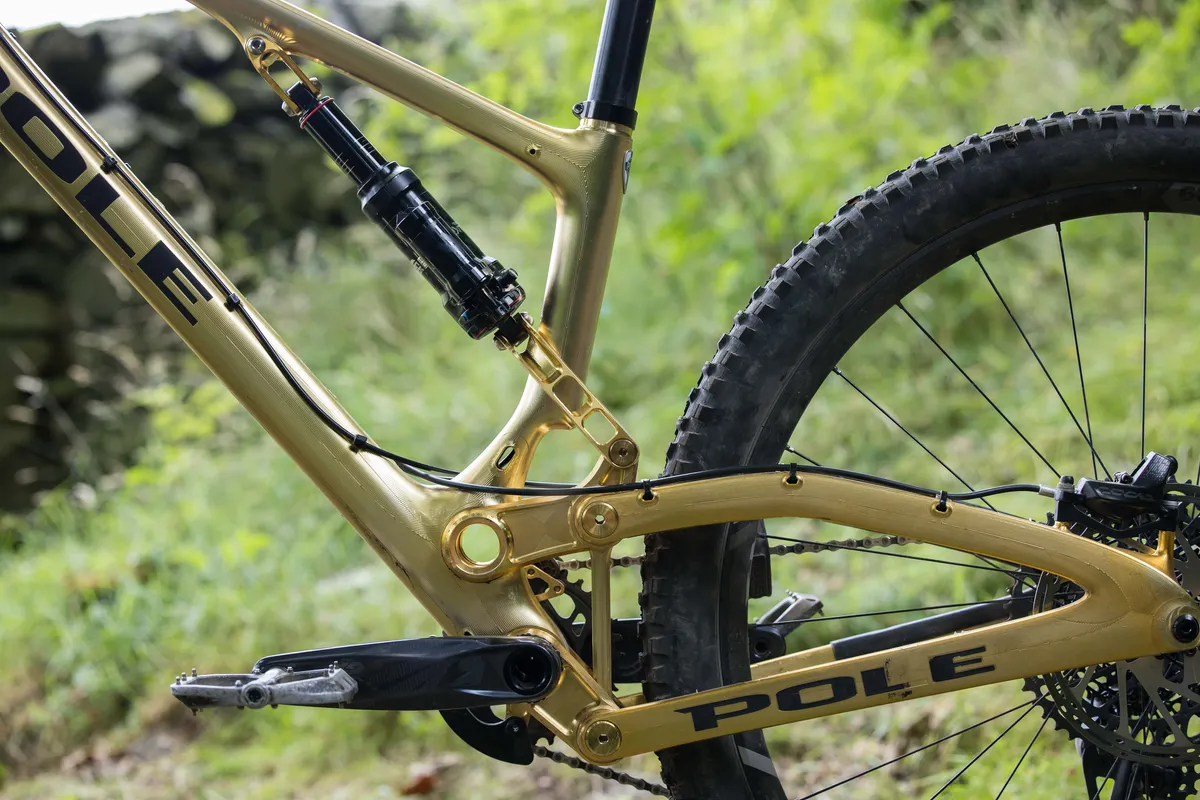
Swapping out this yoke and changing the shock mount transforms the Stamina 160 into the longer travel Stamina 180, although this aftermarket upgrade costs roughly €272. The Stamina 180 can also be converted to a Stamina 160, too.
Details about the suspension’s exact kinematics are a little fleeting on Pole’s site, but according to Spanish website Linkage Design the Stamina 160’s suspension is progressive.
This means it starts out easy to compress and as it goes through its travel it becomes harder to compress. Progressive suspension means the bike can be run fairly soft with more sag than linear or regressive suspension designs which means it should be able to absorb smaller, chatter bumps well and then ramps up to provide mid-stroke support (for turns and compressions), and finally provides plenty of bottom-out resistance to reduce harshness.
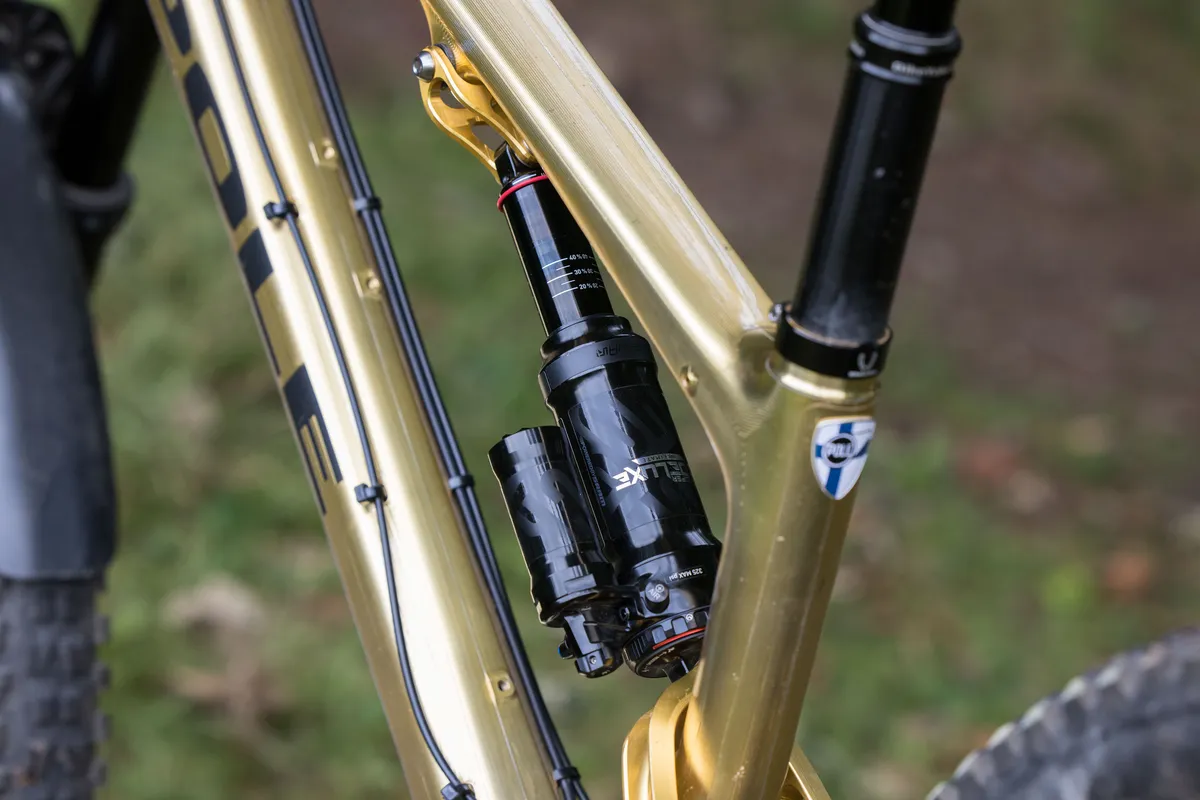
Fitted to the Stamina 160 is RockShox’s Super Deluxe Ultimate RCT air-sprung rear shock with the H (high) rebound tune and L1 (light) compression tune, fitted with two volume reducer tokens.
Leo Kokkonen, Pole’s founder and CEO, told me he believed the light compression tune is perfect for the Stamina’s leverage ratio, while the high rebound tune helps to control the shock when it is returning from deep in its travel.
This stock tune option closely mimics the shim stacks Pole’s enduro racers are using in their custom-tuned shocks.
Pole Stamina 160 Remastered geometry
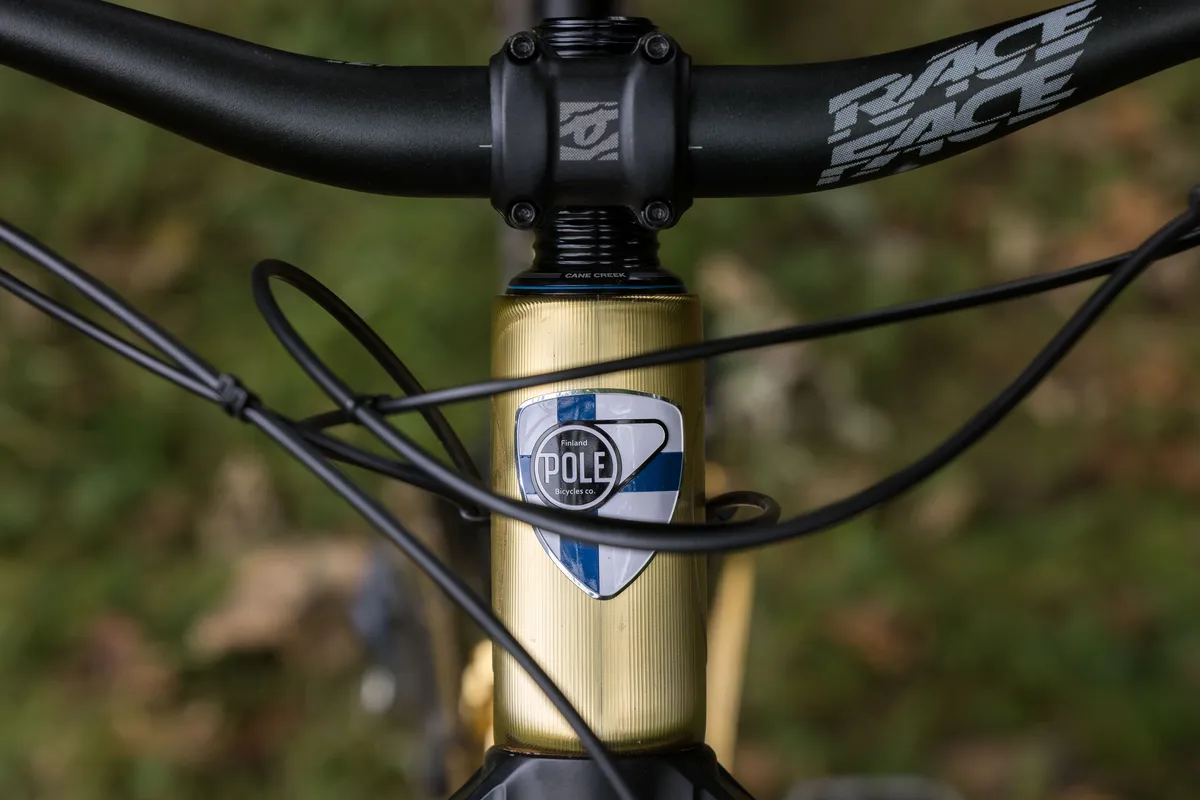
Arguably, the Stamina’s geometry is its crown jewel. Although many people might be scared by the numbers, because even in a market where bikes from most manufacturers are getting bigger, the Pole’s figures still stand out.
The four-size range is designed to fit people from between 160cm up to over 195cm tall. My 178cm height comfortably fell within the K2 size banding, one up from the smallest bike.
Stand out figures on the K2 bike I tested include a generous 480mm reach, long 450mm chainstays, and an impressive 1292mm wheelbase.
Elsewhere there’s a downhill bike slack 63.1-degree head angle (when fitted with 180mm travel RockShox ZEB forks) and an impressively steep 78.3-degree seat tube angle.
| Size | K1 | K2 | K3 | K4 |
|---|---|---|---|---|
| Head angle (degrees) | 63.1 | 63.1 | 63.1 | 62.9 |
| Reach (mm) | 450 | 480 | 510 | 540 |
| Top tube length (mm) | 570 | 600 | 630 | 660 |
| Seat tube angle (degrees) | 78.3 | 78.3 | 78.3 | 78.3 |
| Stack height (mm) | 636 | 645 | 645 | 658 |
| Wheelbase (mm) | 1246 | 1292 | 1326 | 1351 |
| Chainstay length (mm) | 450 | 450 | 450 | 450 |
| Seat tube length (mm) | 400 | 400 | 420 | 440 |
| Head tube length (mm) | 110 | 120 | 120 | 135 |
| Standover height (mm) | 385 | 385 | 405 | 425 |
While these figures look extreme on paper, they’re arguably cohesive out on the trails where each number plays its part in creating the bike’s feel, whether that’s climbing, on the flat or while descending – but more on that shortly.
Pole Stamina 160 Remastered specifications
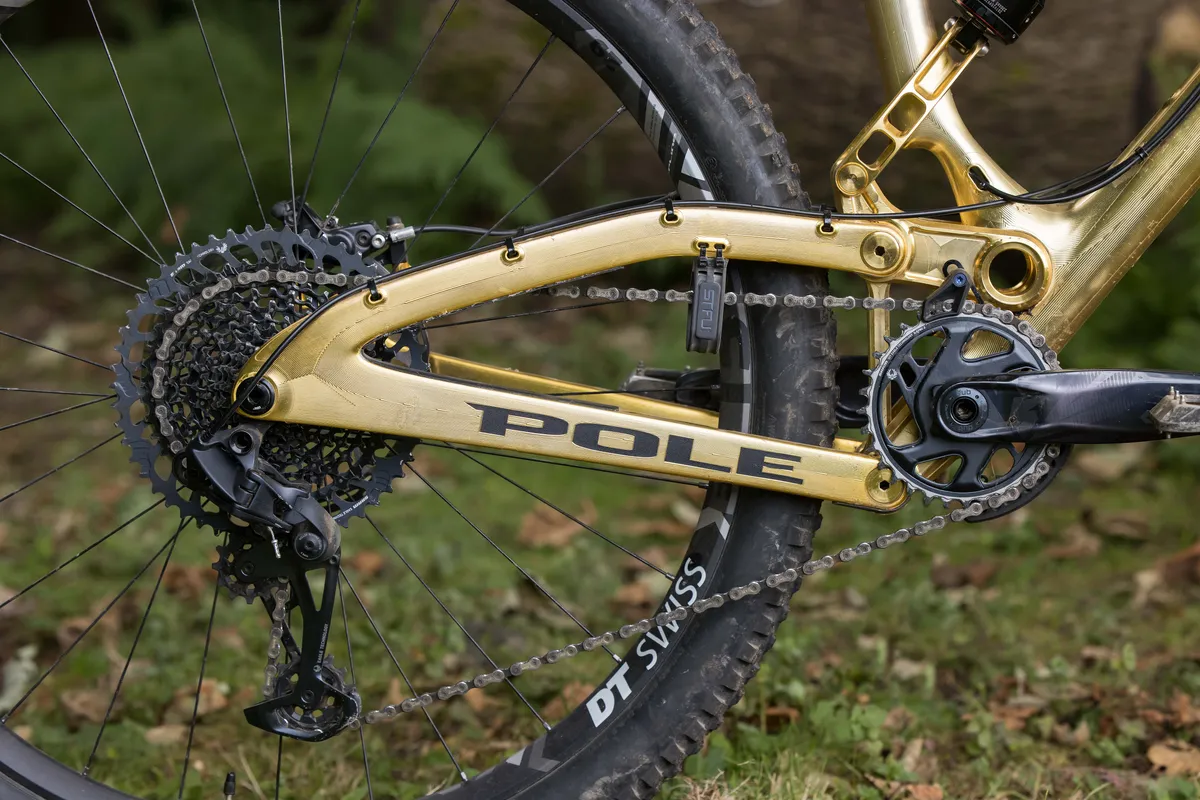
In a year when the bike industry supply chain has been hit by Covid-19 pandemic, it’s impressive to see any bike company putting together a full build bike with seemingly few compromises.
While the spec on the Stamina 160 Remastered is, for the most part, all there, a few less-than-ideal parts have been fitted.
First up is the Bikeyoke Revive dropper post that features a paltry 125mm travel. There is more than enough room for a longer travel post to be fitted, evidenced by the amount of seat post visible above the seat tube.
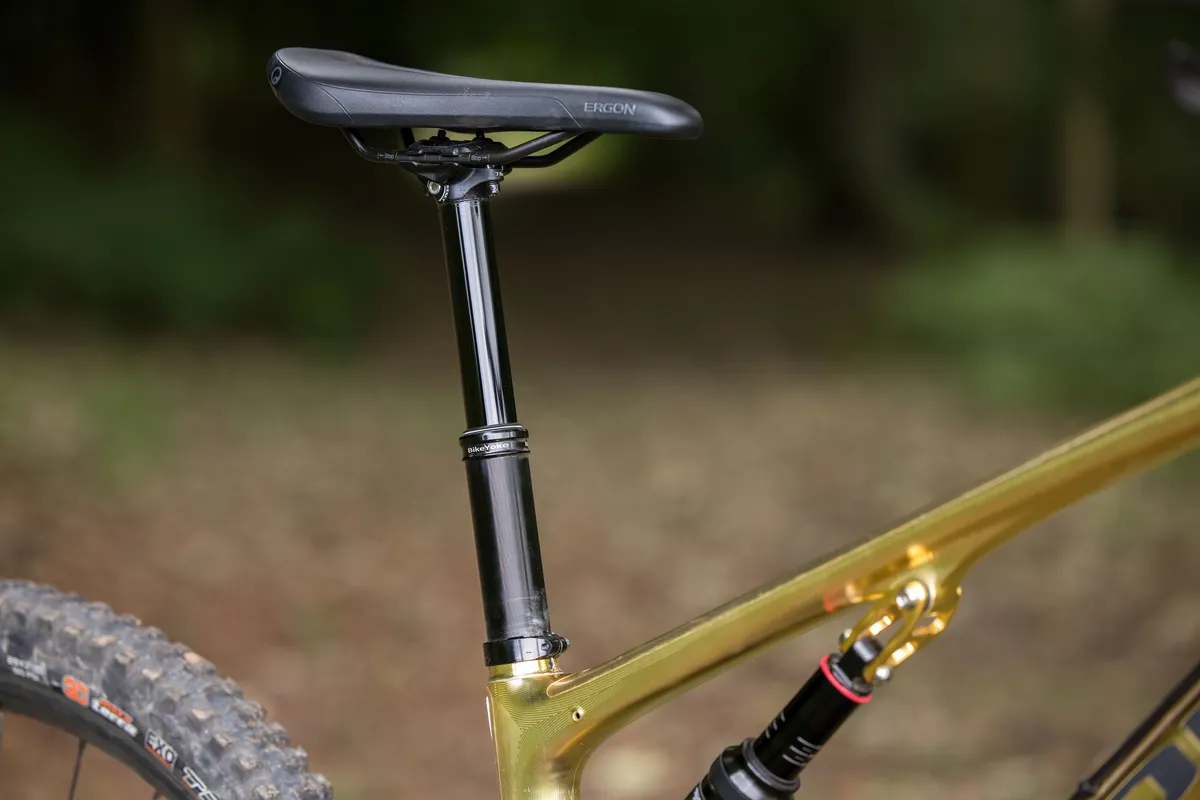
Unfortunately thanks to supply constraint issues, this is the only post travel that was available when this bike was delivered.
Secondly are the EXO-casing Maxxis Minion DHF 3C MaxxGrip 29x2.5in front and Maxxis Minion DHR II 3C MaxxTerra 29x2.3in rear tyres. Leo Kokkonen told me that Pole would have preferred to spec thicker casing tyres to the Stamina 160 Remastered.
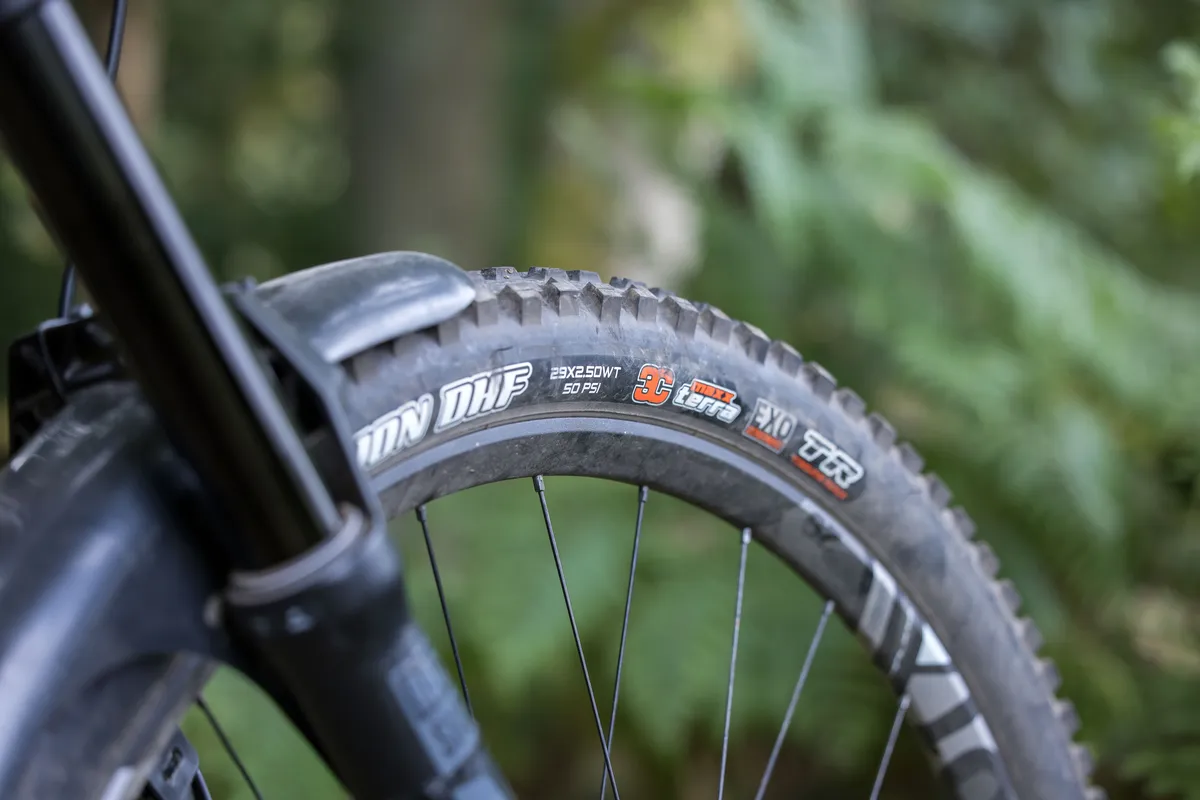
While these tyres are more than suitable for trail riding with the odd foray into more extreme situations, on a bike with a 180mm travel fork there’s no hiding the fact they’re massively under-gunned in terms of sidewall strength to prevent squirming and burping and carcass protection against rips and tears.
To mitigate against the risk of punctures, Pole has specced its in-house Huck Norris tyre inserts. In the front tyre the lightest single-layer Huck Norris Toast insert was fitted, and in the rear was the double-layer Sandwich model. However, compared to using thicker casing tyres, the inserts are limited in how much they can solve the issues associated with thinner casing tyres when specced on enduro bikes, such as rips and tears, pinch flats, and carcass instability.
With that out the way, let’s focus on the good bits.
Up front is RockShox’s ZEB Select fork, specced with 180mm of travel and the Charger RC damper with both external low-speed rebound and compression adjustment. This is matched, as I’ve already said, with RockShox’s Super Deluxe Ultimate RTC rear shock, also with external rebound and compression adjustment and a lockout lever.
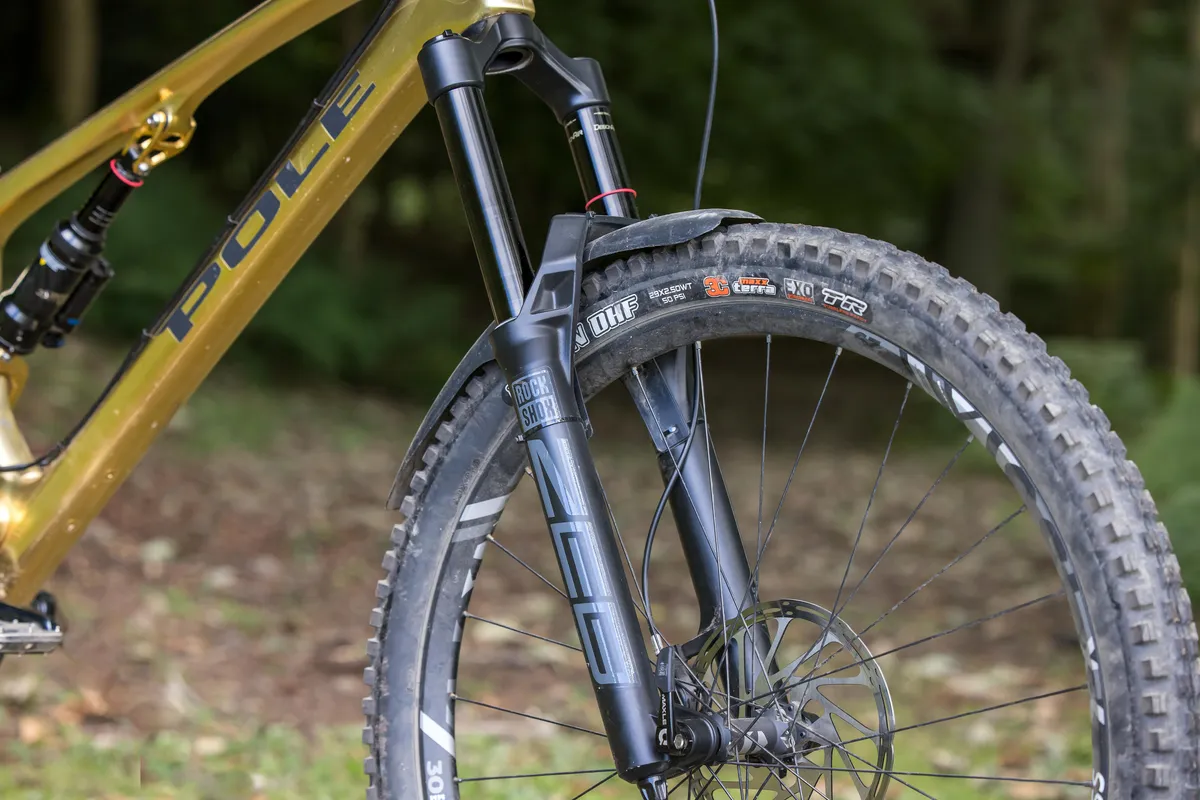
Stopping is taken care of by SRAM’s CODE R brakes with 200mm rotors front and rear. This is matched with SRAM’s GX Eagle drivetrain with the 10-52t cassette and a 32t chainring.
Elsewhere Race Face takes care of the handlebars and stem, with their Chester model, finished off with Lovehandle grips – and further back in the saddle dept, there’s an Ergon SM10.
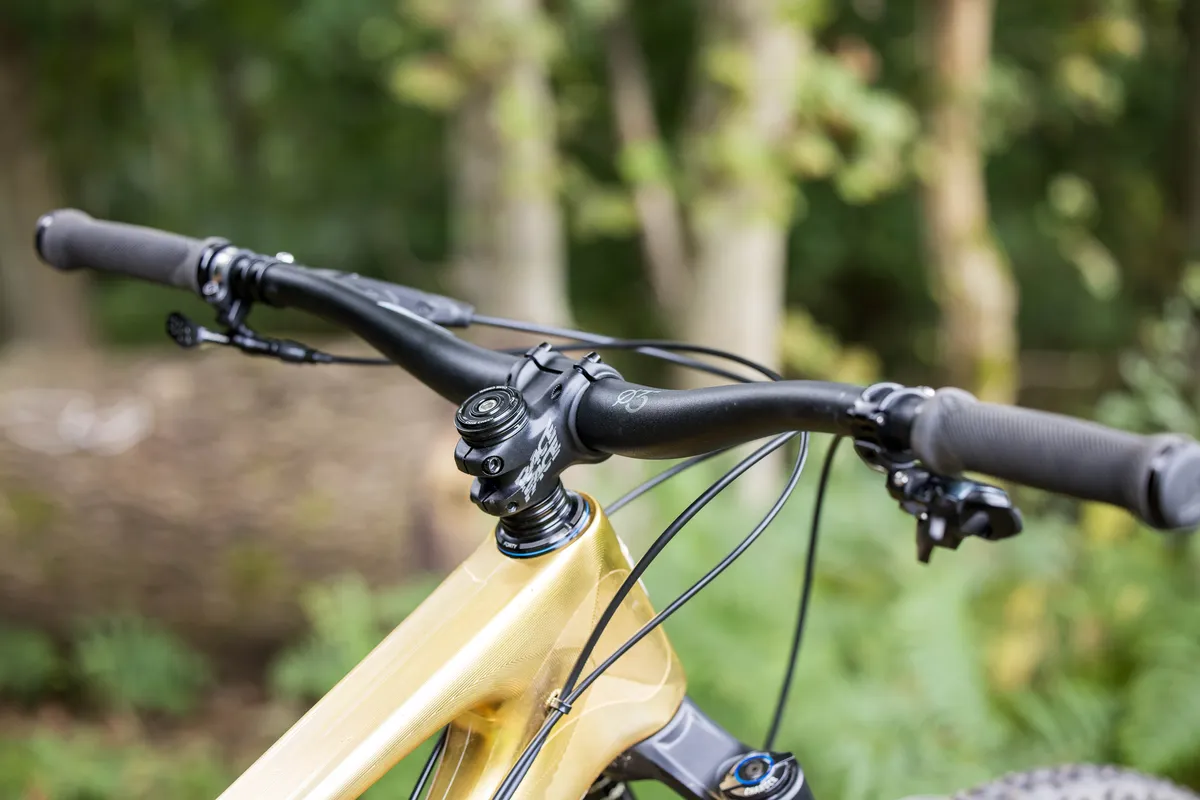
The K2 size test bike weighed 15.77kg without pedals. For comparison, our Enduro Bike of the Year winner, the Trek Slash 8, weighed 15.25kg in a size medium without pedals.
Pole Stamina 160 Remastered ride impressions
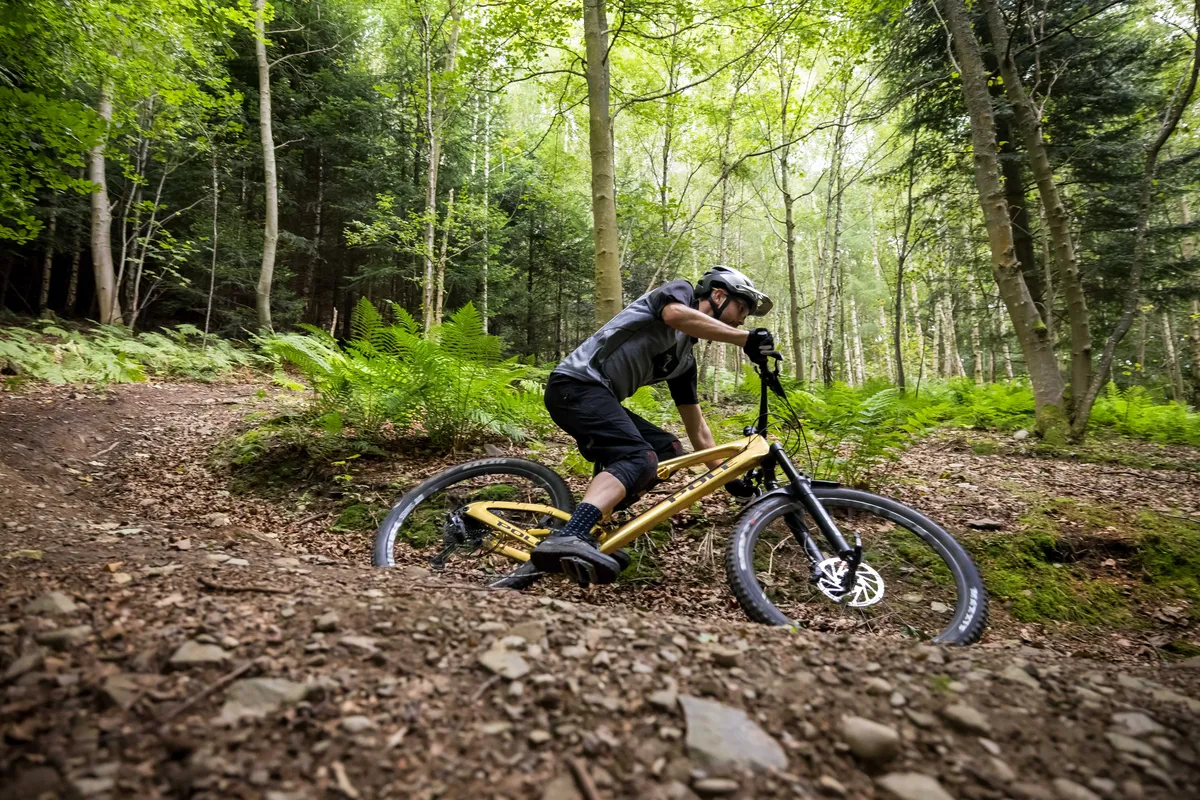
I tested the Pole Stamina 160 Remastered on my home trails in Scotland’s Tweed Valley, host to the UK’s round of the Enduro World Series. Arguably, these are the types of enduro trails it was designed to excel on and the terrain included everything from chunky embedded rock sections through to loose screed slopes, slimy roots, deep mud and sun-baked dust.
Not only did I ride the bike on these trails, I also took it down high-speed downhill bike tracks used for UK national-level races and around gentle red and blue graded trail centre loops.
Needless to say, it got a thorough workout.
Pole Stamina 160 Remastered setup
I initially felt like I couldn’t get the bike to perform as I expected it should, given the frame’s kinematics, the suspension, and parts bolted to it.
For my 77kg fully kitted-up weight, I started with 155psi in the rear shock with the stock two volume reducer tokens installed and I had the externally adjustable compression and rebound adjustment set fully open. This gave me roughly 27 per cent sag, but I struggled to use full travel when I expected to. I had the fork set to 75psi with zero tokens and the compression damping set to fully open, with rebound adjusted to taste.
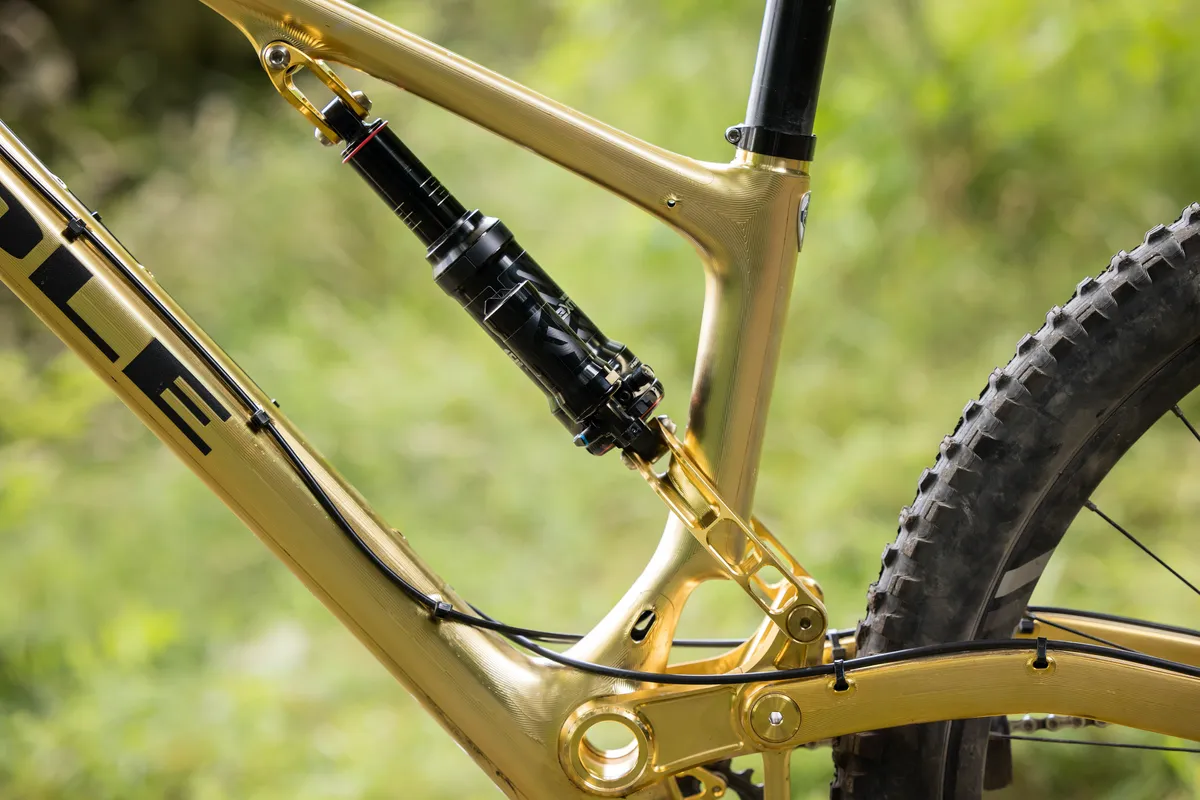
After some initial testing, I removed the rear shock’s two tokens, but kept the spring inflated to 155psi. This only increased sag slightly to 28 per cent but now this meant I was using more of the travel more of the time and was getting close to, and bottoming out, when I expected to.
It was the same story with the fork, where I initially fitted 2 tokens with 75psi and was unable to reach full travel in scenarios when I would expect to. I reduced the spring pressure until I felt like they were using the correct amount of travel, finally ending up with 60psi and zero volume reducer tokens. Set like this, the fork had roughly 18 per cent sag.
I inflated the tyres to 23.3psi front and 27.6psi rear with the Huck Norris inserts installed. These pressures were as low as I dared to go with the stock EXO casing tyres, and it was possible to pinch both the front and rear tyres’ sidewalls and feel the insert installed within.
Pole Stamina 160 Remastered climbing performance
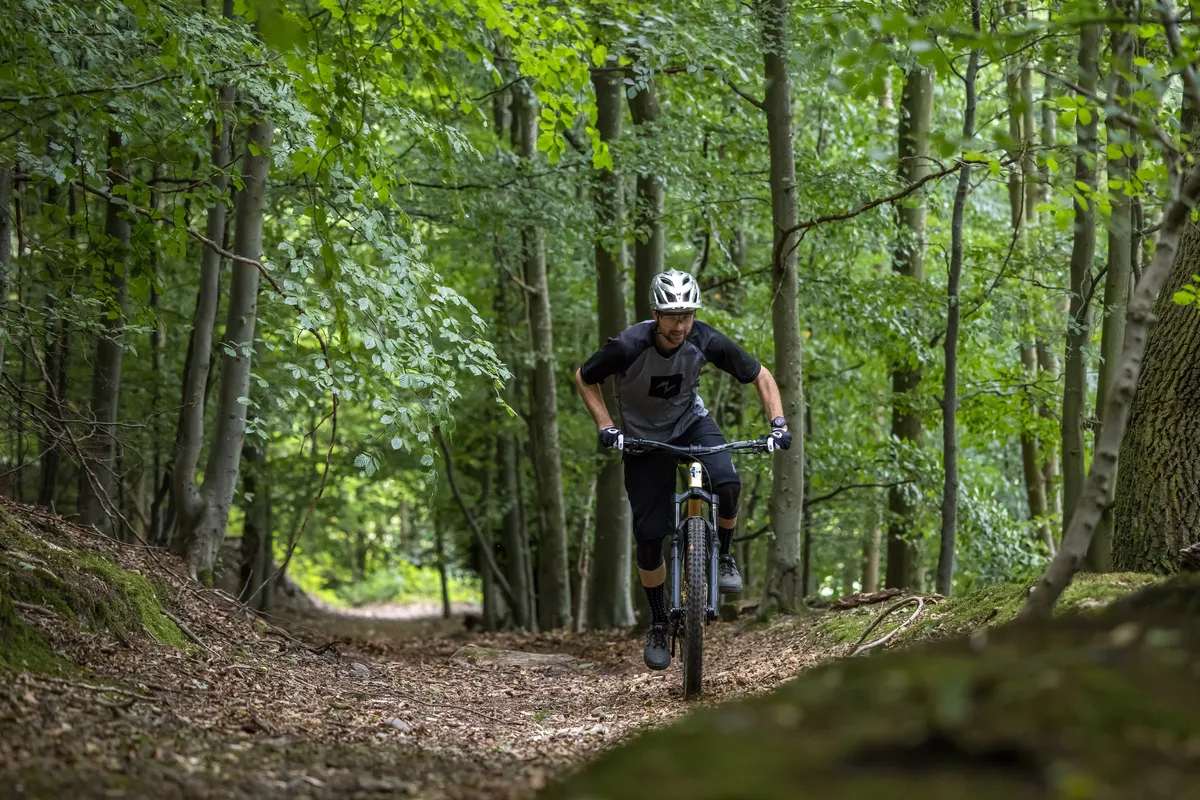
Point the Stamina uphill and not only is the ride relaxing, but also impressively rewarding and direct.
I’d happily go as far as to say I’ve never ridden a bike that’s as comfortable to point uphill – as long as outright speed isn’t the aim.
My weight felt impeccably centred over the middle of the bike which helped not only improve comfort – as my hips were directly above the bottom bracket rather than miles behind it which improved pedalling efficiency – but also increased the amount of grip and control on offer on more technical or steeper sections.
That was because I wasn’t shifting my weight fore or aft to compensate for the front wheel lifting or getting bounced offline because the front wheel was unweighted. I also didn’t need to move over the rear of the bike to improve traction and stop the wheel spinning.
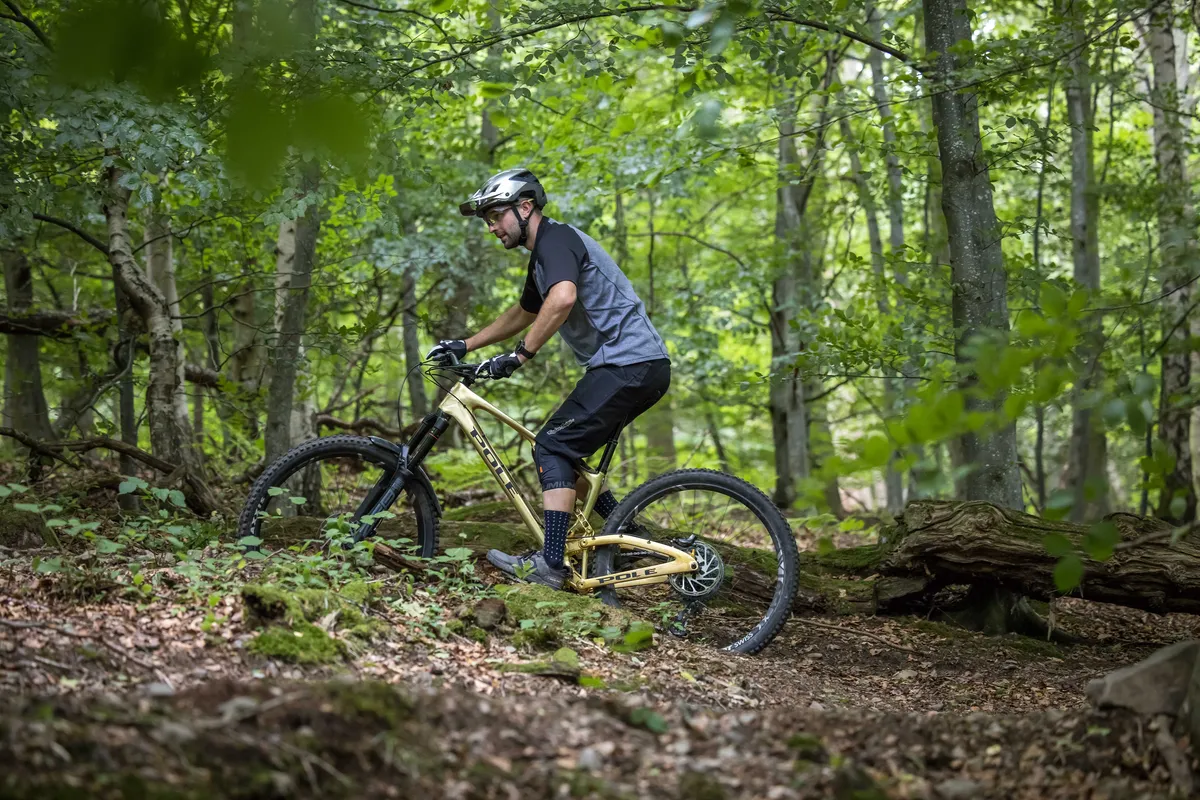
Its calmness also helped decrease the amount of energy needed to ride sections, which was backed up by a very calm-feeling rear end that had very limited pedal bob.
Whether I was spinning to the top of a climb in a low gear at slow speed while seated or grinding in a higher one standing up, the rear suspension remained impressively inert, refusing to move enough to perceptibly interfere with how much of my effort was converted into forward motion.
This meant I didn’t feel like I needed to reach for the shock’s lockout lever to firm things up, either.
Although the suspension felt supple enough to remove the majority of the biggest bumps and create traction, I wouldn’t go as far as to describe it as miraculously smooth, especially compared to more fluttery bikes, such as my old Yeti SB165 long-term test bike.
As I previously mentioned, the dropper seat post needs significantly more travel to avoid the need to manually adjust it up and down in the frame and reduce the amount of exposed seat post above the seat tube clamp.
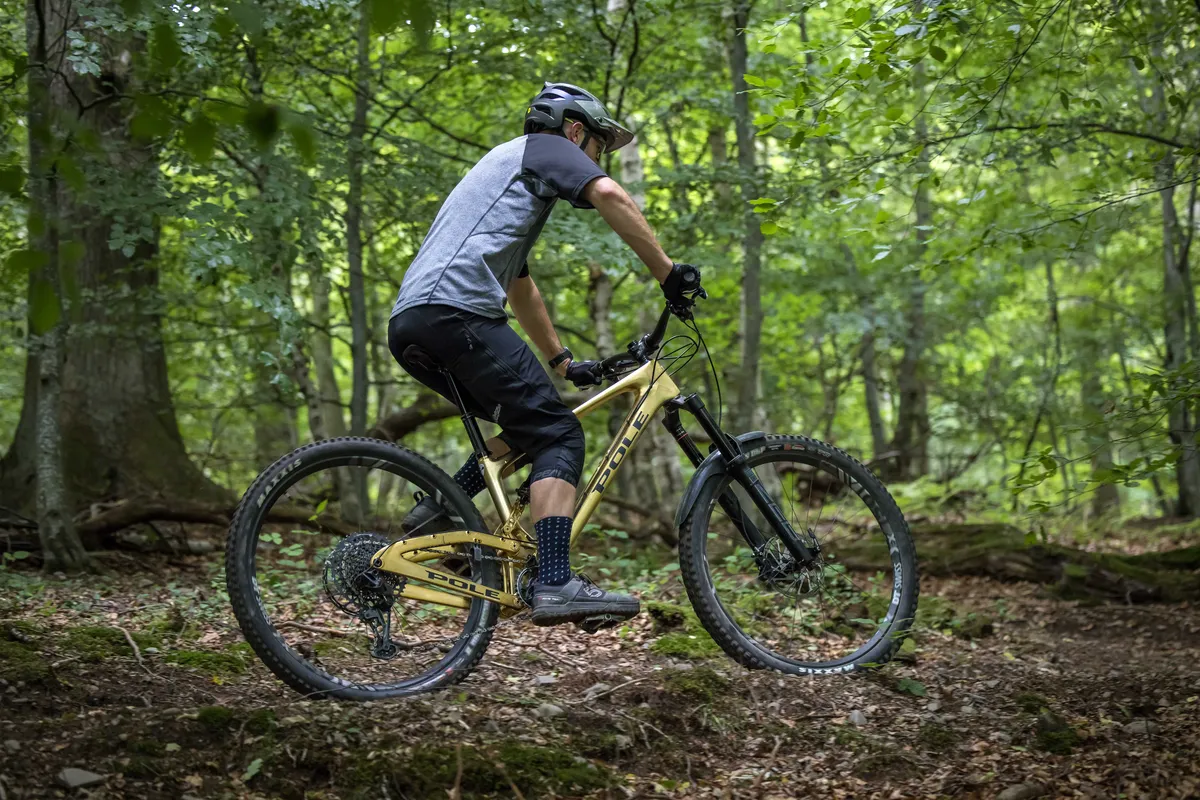
Swapping this dropper out for a longer travel one isn’t an overly complicated task given the bike’s externally routed cables.
I personally found the Ergon SM10 saddle exerted excessive pressure on my perineum, but not every rider will have the same issue.
And despite Pole’s claims that this model of the Stamina has been specced for performance and reliability over outright weight saving, I didn’t feel that its 15.77kg weight was too heavy or energy-sapping, even during long days in the saddle.
Clearly, the spot-on geometry helps mitigate some of that weight that you’d otherwise be struggling to propel upwards thanks to less-than-ideal climbing positions.
Generally, I found that climbing, for a bike with such a downhill focus, was mightily impressive. Back-to-back testing the Stamina with bikes with slacker seat tube angle really highlighted just how good it was.
Pole Stamina 160 Remastered descending performance
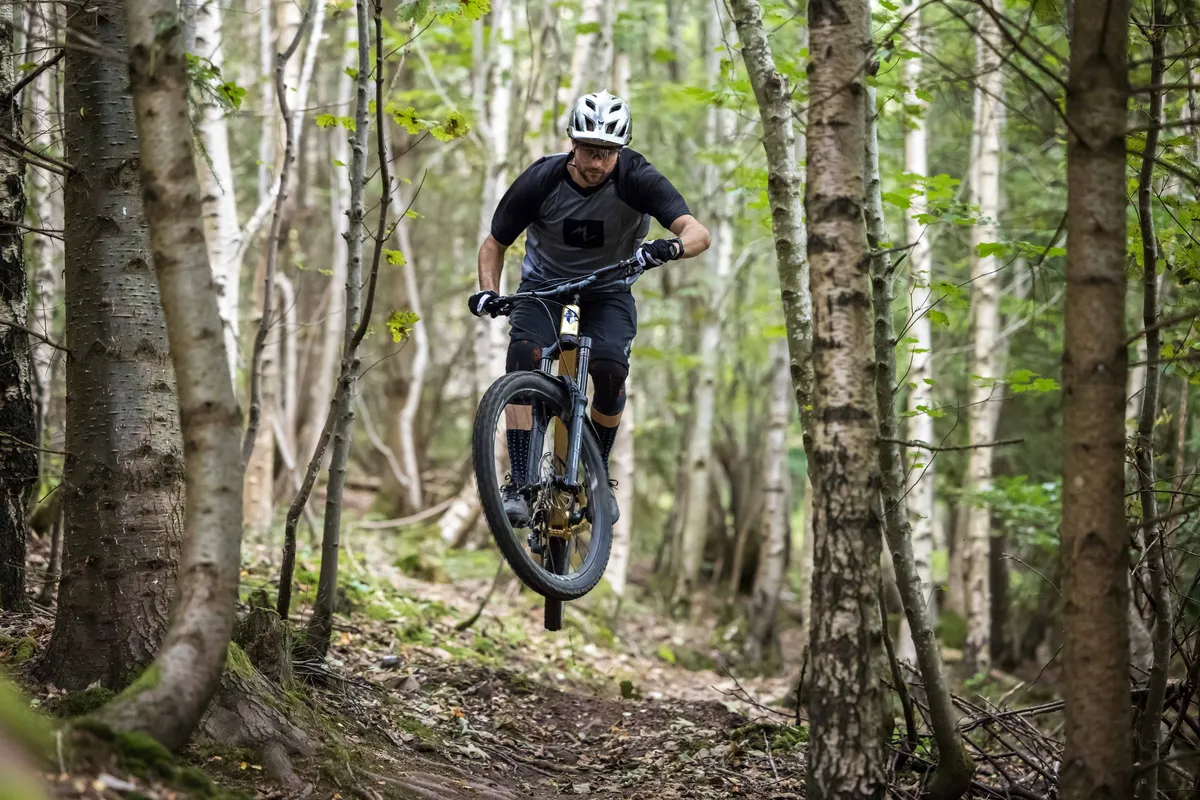
The Stamina 160 Remastered descending prowess is dominated and created by its forward-thinking geometry, that up until recently was considered very extreme, and only matched by a handful of bikes – such as Nicolai’s GeoMetron and before that, Mondraker’s Forward Geometry design – made by brands with similar theories on bike handling.
Although the Stamina 160 Remastered’s geometry is more conservative than the Stamina 180 Remastered bike, where like-for-like sizing of the K2 model sees the 180 get a 455mm chainstay and a 1306mm wheelbase, both up on the 160’s figures, and despite Pole’s claims the 160 is a 'party ride', it’s still arguably a lot longer and stretched out than plenty of its competition.
For example, Nukeproof’s Mega 290 in a medium has a 64-degree head tube angle, 455mm reach, 1,222mm wheelbase, and 440mm chainstays.
Dominant geometry
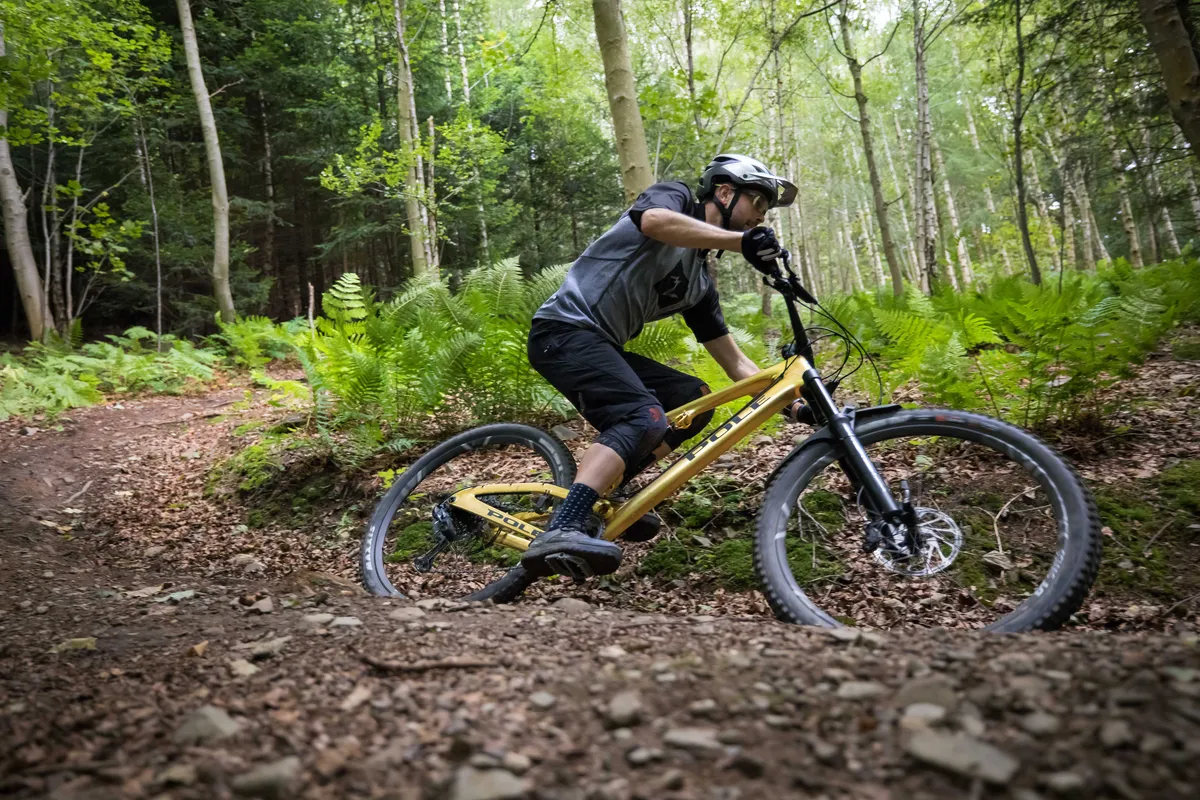
What do the Pole’s stretched-out figures mean out on the trail, then?
Point it down steep, gnarly, fast and rough trails and it’s remarkably stable and calm.
I felt perfectly centred on the bike when the trail gradients increased massively, not needing to compensate for a short back end, steep head tube angle or cramped reach figure by shifting my weight rearward and subsequently unloading the front wheel.
This meant cornering and braking traction were exceptional and the front to back wheel balance was almost perfect.
The amount of bike both in front of and behind the pedals thanks to the 851mm front centre (the distance between the front axle and bottom bracket) and chainstay lengths, created an unusual but remarkable feeling when I was really hoofing down a favourite steep test track of mine, dubbed 'Prospacker' (which featured in the UK’s round of the 2014 Enduro World Series and has an average gradient of roughly -20 per cent and sections that touch -40 per cent).
It made me feel like I couldn’t lean far enough forward on to the front wheel even if I tried, in places where I’d usually be trying to get my weight over the rear of bikes. This feeling created confidence as the bike felt like it was never going to become twitchy to steer or pitch forward and chuck me over the bars if I weighted the front wheel harder.
This essentially flattened out steep sections, making them less difficult to ride and improving control, grip, and confidence.
I was sceptical that this sort of geometry would excel on flatter, slower, less technical, or tight and twisty tracks given the belief many manufacturers and bike reviewers have that long, slack and low makes them sluggish and hard to manoeuvre.

I needn’t have worried.
Switching between tight berms wasn’t tricky and neither did it require excessive amounts of body or weight shift to get the bike to change direction.
I felt the same on tighter, flatter turns where it was still possible to get the rear end of the bike to break traction and slap into successive hits without experiencing the Ever-given-stuck-in-the-Suez-Canal situation some people would have you think.
I will admit my movements required to get the bike to change direction were more deliberate than on shorter bikes, but they weren’t prohibitively large, strenuous, exaggerated or forced in comparison.
This made the ride revolutionary in its calmness which equated to outright speed.
The Stamina is monstrously quick on the trails as a result, something I’m confident Leo Kokkonen, Pole’s founder, set out to achieve with the bike. If speed is your thing, I’m confident in saying that you won’t be disappointed with the Stamina.
The payoff for that outright speed is that it’s not mind-blowingly fun. Rather, it gets the job done efficiently and quickly, and I never found myself whooping and hollering at the bottom of the trail. I was, however, always in awe of the speed and control it permitted.
A red herring investigation
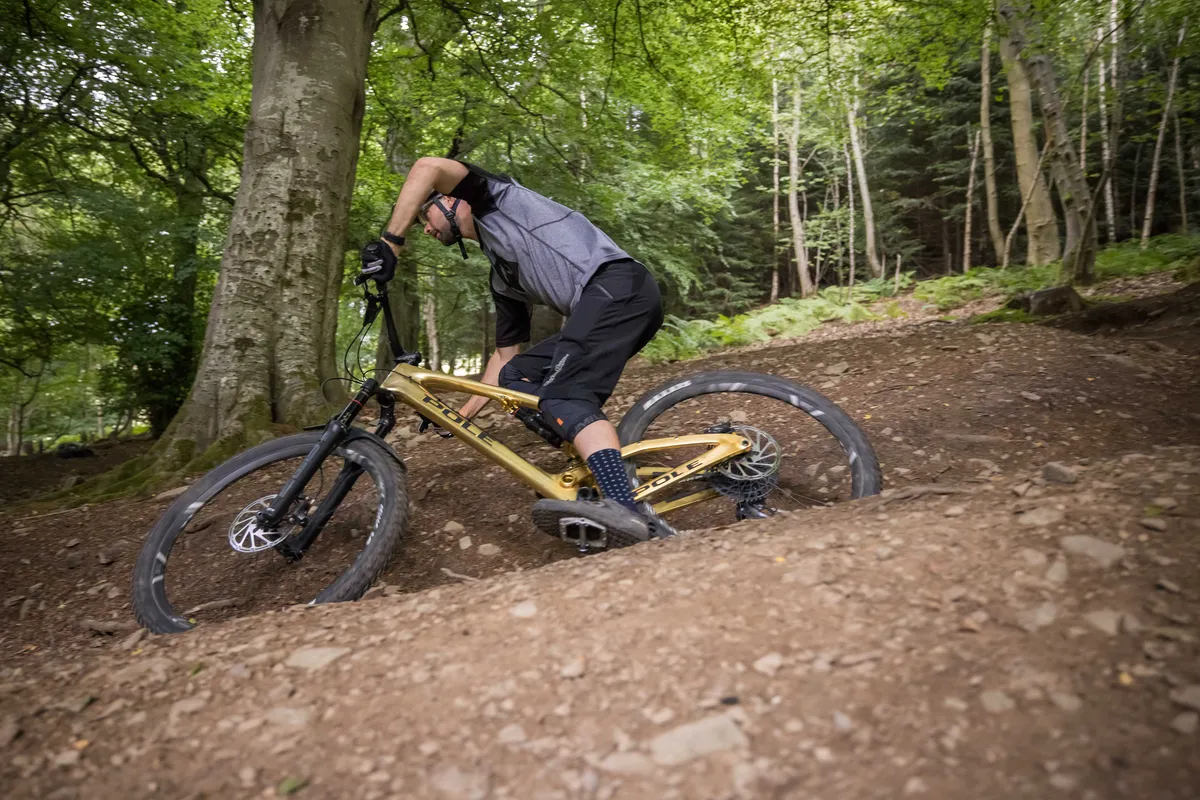
Getting the Pole feeling this good wasn’t plain sailing however, and my testing notes are riddled with question marks over the suspension’s leverage rates, shock tunes, spec choices such as the tyres and wheels, and forks, and general ride feel.
Initial ride impressions with the rear shock fitted with two tokens revealed it felt harsh over and through larger hits such as chunky roots or rocks, and large holes, where I felt like I was working hard to keep my feet engaged with the pedals.
Although that was the overriding issue at this point, there was an underlying pinginess to the way it rode, too. Smaller vibrations such as loose marble-like rocks or stutter bumps were transmitted into my hands and feet, reducing grip and control.
The bike felt like an engaged lockout lever was causing it to feel harsh, and that deeper into the travel it had too much compression damping, or too much ramp up.
Suspension setup
I initially reduced air pressure to help improve comfort but left the two factory-fit tokens installed. This made the bike more eager to use its travel, but I was still struggling to use the amount of suspension I was expecting on the terrain I was riding.
In the same vein, it marginally reduced the pingy harsh feelings over smaller bumps, but not as much as I was expecting.
The next step was to remove the rear shock’s tokens to increase the spring’s air volume and reduce the amount of shock progression. Once again, this further improved the suspension’s ability to absorb bigger hits, and I was now getting much more travel, and even bottoming out when I expected to. Although removing them didn’t turn the Stamina into a plough bike, it certainly improved its ability to absorb big hits.
The progressive-feeling rear end would certainly suit the linear nature of a coil shock.
I still wasn’t satisfied with how quickly it recovered – how fast the rebound damping permitted the shock to extend – from deep in its travel, speculating this might be contributing to some of the harshness. I was wondering if the shock wasn’t able to return quick enough from deep in its travel to be able to absorb the next hit.
I first began thinking about this when testing the Pole back-to-back with a different bike fitted with a Fox Float X2 rear shock, where I had set the high-speed rebound damping adjustment to fully open.
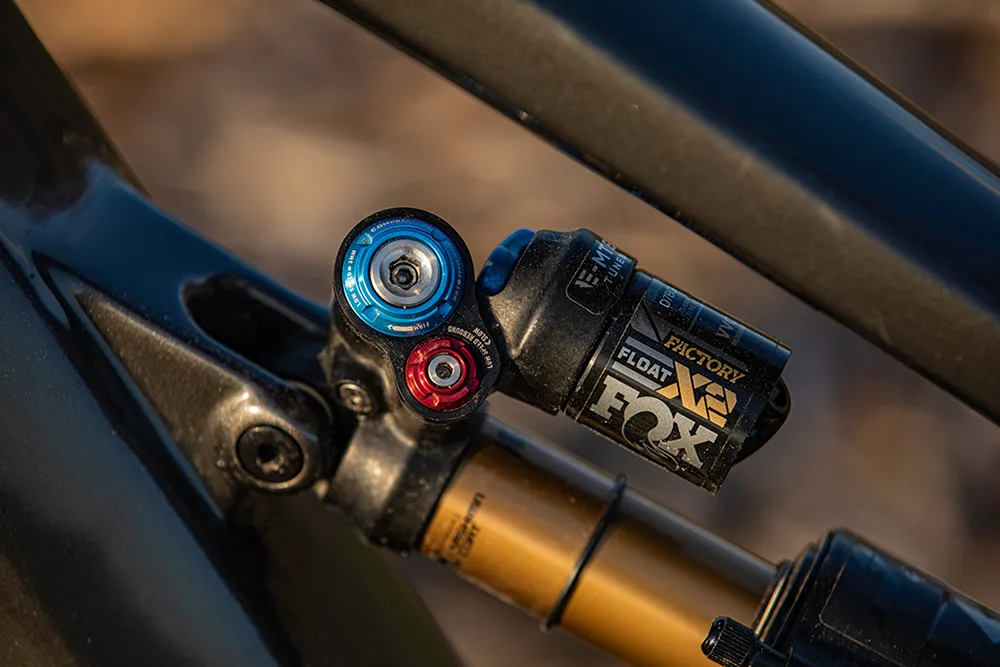
In high load turns where the bike was compressed deep into its travel the other test bike felt like it was livelier and not compressing as far into its travel. I also felt like the other test bike wasn’t as harsh deeper into its travel and I wasn’t clawing at the pedals with my feet to improve control.
The Pole squatted into turns rather than trying to propel me out of them and felt dead rather than lively through the pedals. The ‘high’/hard high-speed rebound tune – where the shock's rebound damping is increased as the shock is returning from deep in its stroke – could have been the cause of this.
Leo Kokkonen told me he decided to spec the high rebound tune after spending hours testing and developing the bike with the Pole enduro race team. Whether you will find that characteristic good or bad is another question, but I adapted to how it rode quickly.
Despite all these changes and lines of enquiry, the underlying pinginess was still there, and I was convinced it shouldn’t be. Its deep-travel performance was better, but high-speed, high-frequency, small hits were an issue.
Having done my best to eliminate the suspension as the cause, I began investigating the wheel, insert, and tyre combination as the next probable cause.
Wheel and tyre dilemma
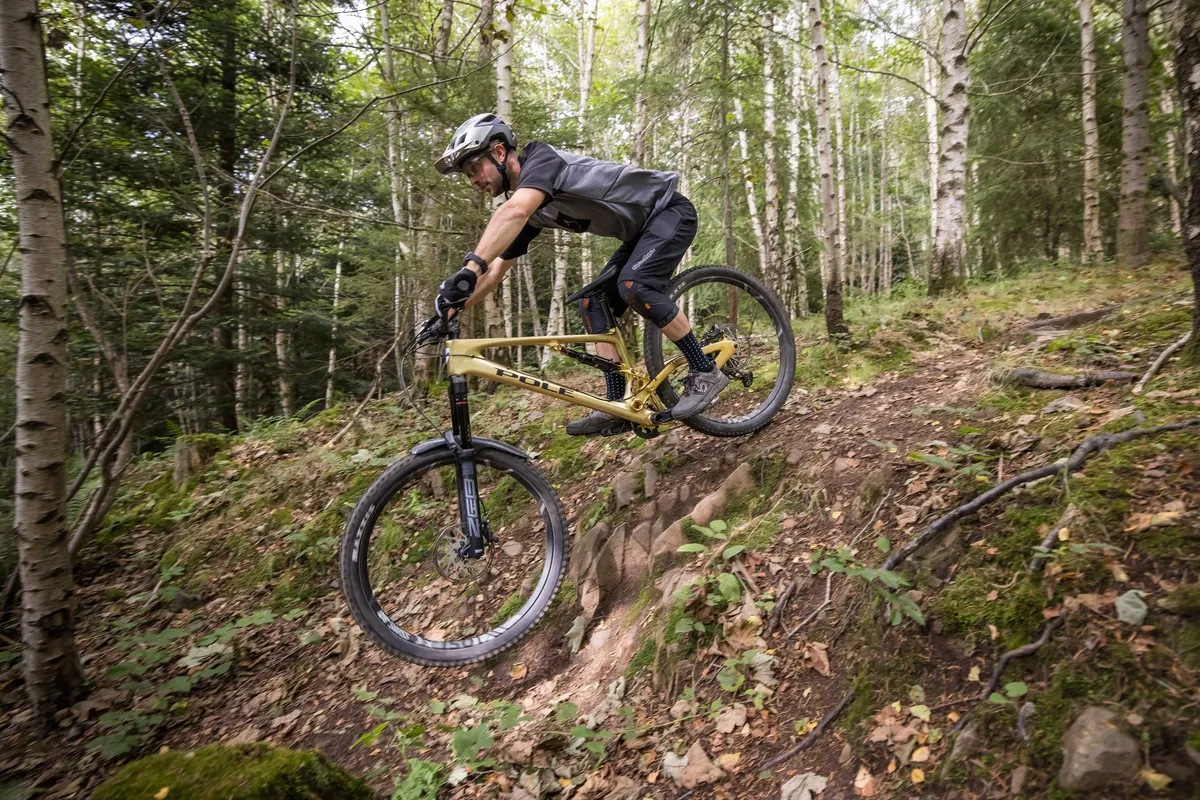
I initially swapped the stock wheels and tyres out for a set of DT Swiss EX1700 wrapped in Specialized Butcher GRID Gravity rubber I borrowed from the 2022 Specialized Turbo Levo test bike’s front wheel.
I wanted to see whether changing the wheels and tyres had any effect before investigating more thoroughly. Initial impressions were positive, and the pinginess was dramatically reduced, helping improve comfort, control and, importantly, traction.
Further investigation was required to find out what part of the stock setup was the biggest factor in causing this.
With the stock tyres, inserts and rims fitted, I reduced tyre pressures by two psi on both the front and rear tyres down to 21.3psi and 25.6psi respectively. This improved how the bike rode, making it feel smoother and more controlled, but it wasn’t perfect with an element of harshness remaining. At lower pressures the sidewalls had less tension, giving a more damped feel. However, this caused the tyres to feel squirmy and vague when pushed hard through turns and resulted in some large impacts through the bike when the tyres bottomed out onto the insert, and the insert onto the rim.
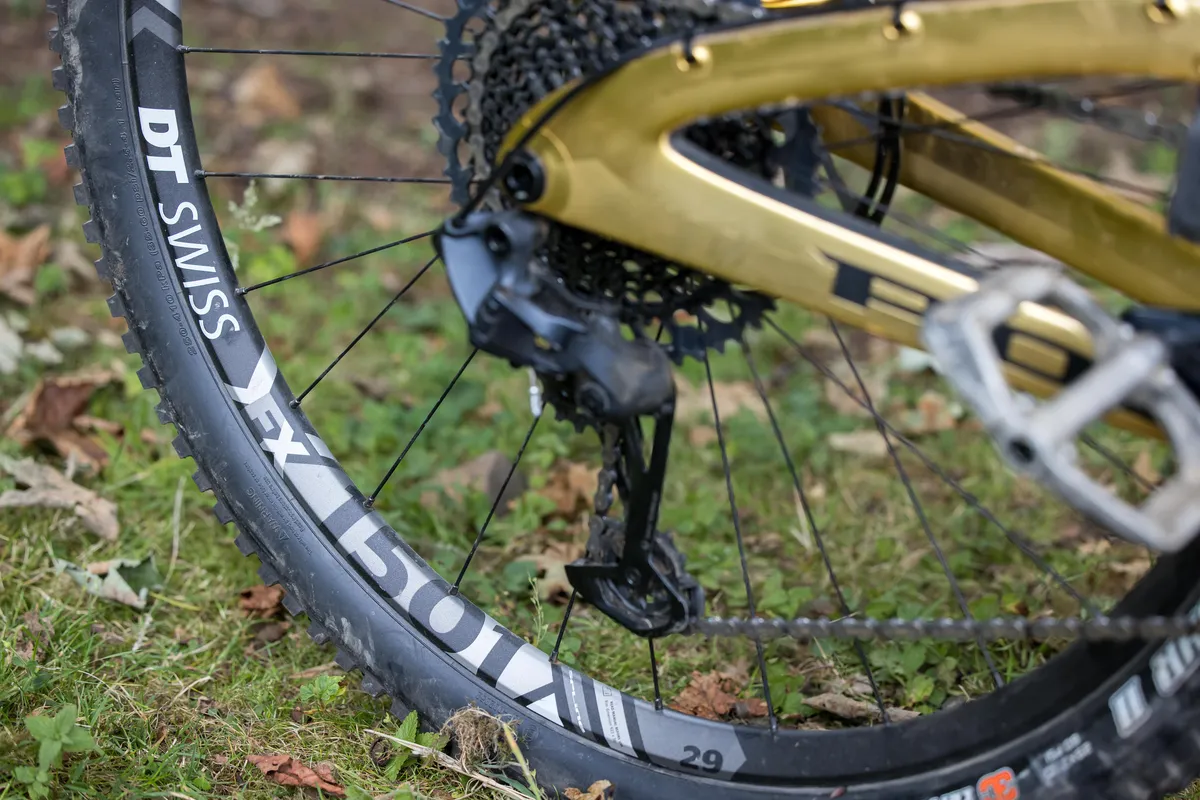
Then I removed the Huck Norris inserts but kept the stock wheels and tyres fitted. I inflated them to the same initial pressure as I had with the inserts installed. There was a noted reduction in pinginess over loose rocks and smaller trail chatter, and arguably they felt gripper when set to the original pressures, but weren’t as grippy or smooth as was when I had simply reduced tyre pressures and kept the inserts in.
However, at the higher pressures, I experienced less sidewall flex and steering vagueness but the payoff for this was a reduction in puncture protection from pinches and tears when compared to running the inserts.
Next up, I removed the EXO casing tyres and fitted a Maxxis Double Down casing Assegai MaxxGrip 29x2.5in and Minion DHR II MaxxGrip 29x2.4in combination to the front and rear respectively. I inflated them to the original, higher, pressures.
The difference was like night and day. Suddenly the Pole felt smooth and calm to ride, with plenty of damping on harsh, chattery terrain. I was no longer getting pinged off-line and revelled in the increased stability. This was how I was expecting the bike to ride.
Set at the higher pressures, I didn’t experience any in-turn carcass flex and I didn’t ding the rims or puncture the tyres when hitting harsh rocks at speed.
Of course, there are caveats to my findings. Lighter riders might not struggle with carcass flex or punctures with EXO casing tyres at lower pressures, and heavier riders might prefer – or need – the inserts with Double Down casing tyres, but if you’re in the market for a Stamina 160 Remastered, I couldn’t recommend swapping out the stock tyres to thicker casing ones enough.
An imperfect spec
It’s not just the tyres that left me scratching my head.
The K2 sized bike I tested was fitted with a 125mm travel dropper post. This meant I had 120mm of nonadjustable seat post showing the clamp and travel adjustable section. Although this spec choice was probably because of coronavirus-related supply issues, it’s certainly something worth considering if you’re planning on ordering a Stamina.
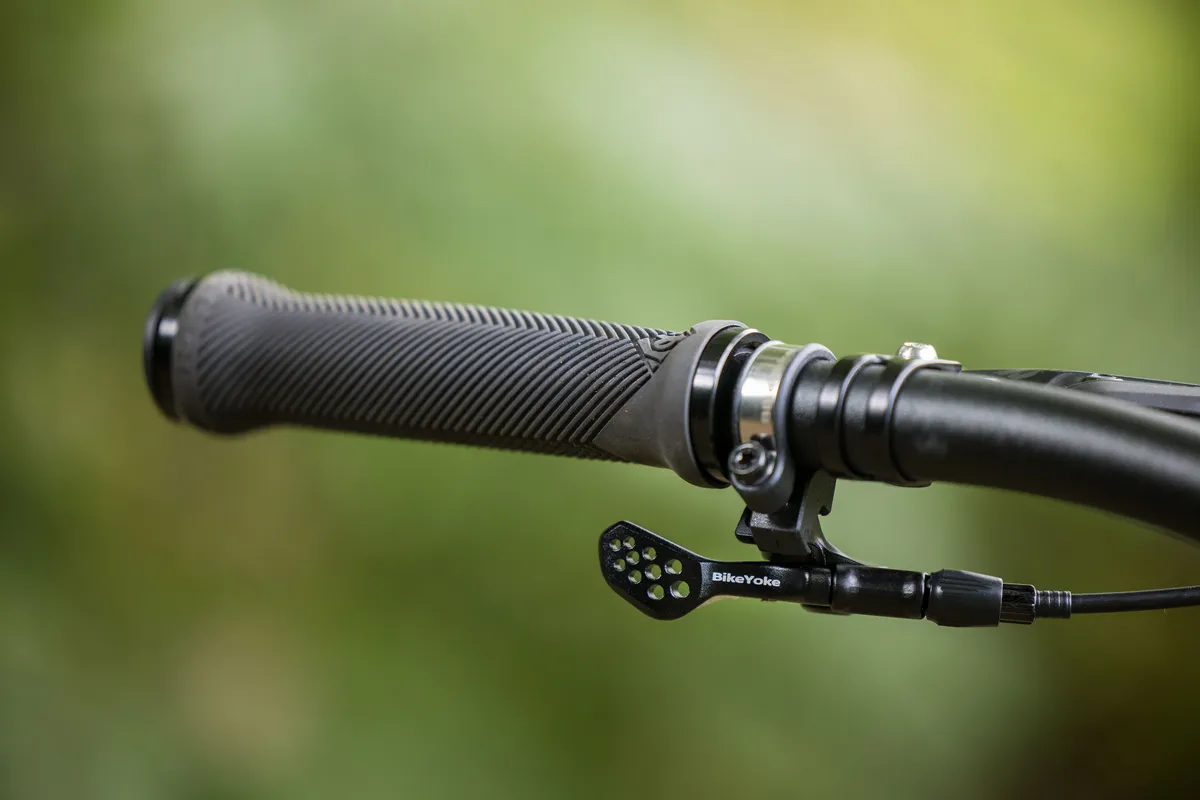
I found the Race Face Lovehandle grips to be uncomfortable thanks to their stepped outer edge. If, like me, you hold the bars with the outside edge of your hands over the end of the grips, these grips are terribly uncomfortable. Changing the grips to your personal favourites isn’t a big issue, but it would be great if the bike was specced with a more universally compatible and comfortable pair from the factory.
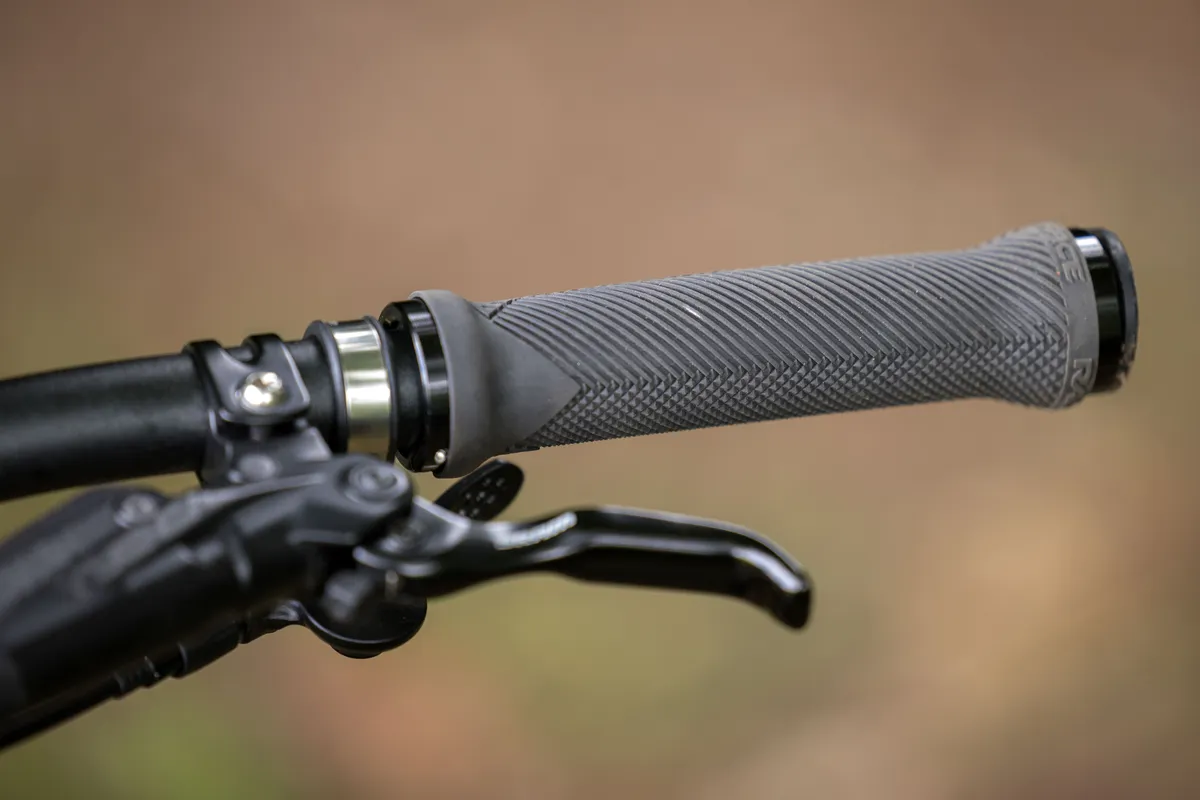
I’ve spoken about the tyres at length, but for a rowdy enduro bike Double Down or Super Gravity style casing tyres should be specced from the factory. Mitigating against the problems caused by thinner casing tyres is too compromised compared to speccing thick tyres from the outset.
RockShox’s ZEB fork isn’t as supple or supportive as the Fox 38 (that my colleagues and I have criticised for being over-damped, feeling best without any compression or rebound damping adjustment dialled on) for any given spring pressure. Arguably the widely reported lack of off-the-top smoothness of the ZEB contributed to the overall harshness I felt, although this was mostly caused by the EXO casing tyres.
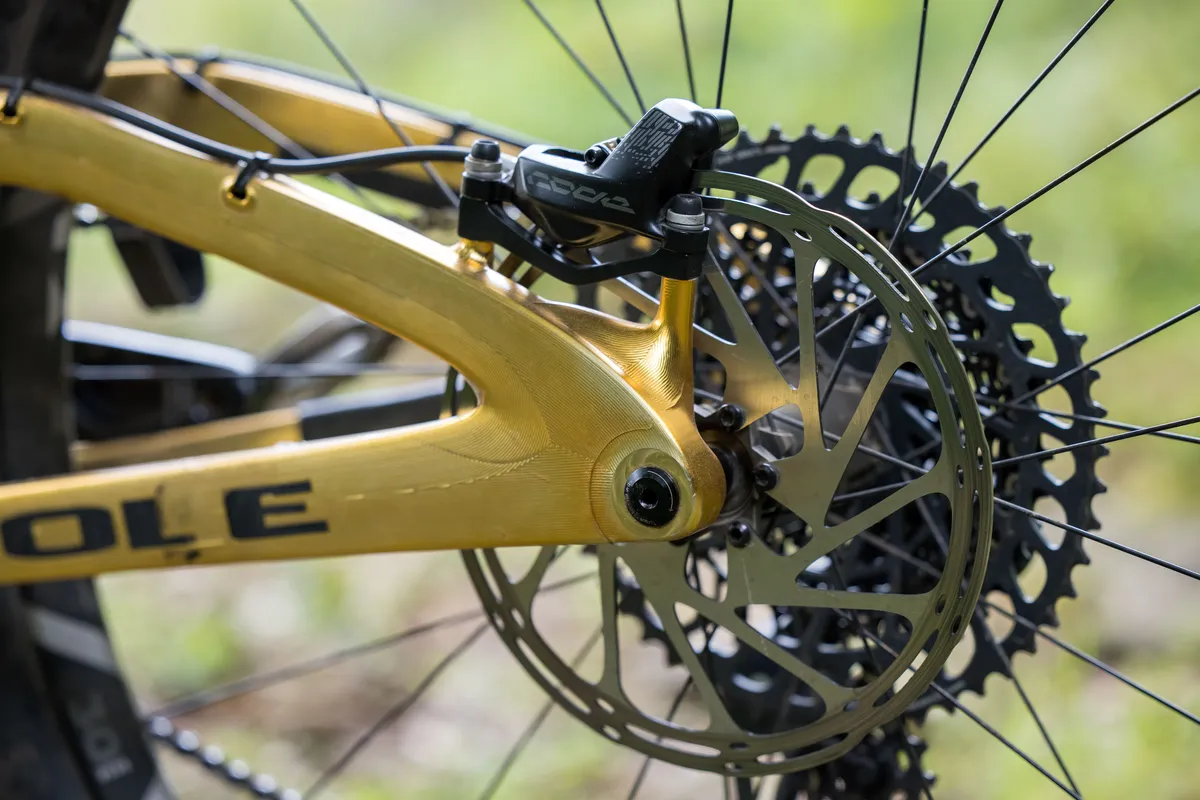
Although the ZEB isn’t wildly harsh, it isn’t as smooth as it should be. The general solution to this problem is to reduce spring pressures, but the payoff for this is a reduction in mid-stroke support in compressions and around berms.
Although adding volume spacers would help with mid-stroke support, I struggled to reach full travel on the ZEB with zero spacers installed.
To top it off, the ZEB Select fitted to the Stamina doesn’t have separate high- and low-speed compression adjustment, instead having a single compression adjuster on the top of the fork leg. Increasing compression damping, while helping the fork remain higher in its travel in holes and turns, did increase the harshness.
Striking the balance between responsiveness, support, and still being able to use full travel proved to be almost impossible with this fork.
However, all these issues are remediable with changes to the bike’s spec.
Design details
Clearly, plenty of thought has gone into the Stamina’s unique design and looks.
First up, the triple water bottle mounts will be music to the ears of thirsty riders, or people who spend long days in the hills. The externally-routed cables should please those who don’t like to spend hours maintaining gears and brakes, and the SRAM UDH should mean replacements are widely available.
Although there are six pivot locations with bearings on the Stamina, I didn’t have any issues with them during the test period. It remains to be seen whether they stand the test of time or harsh northern-hemisphere winters, however.
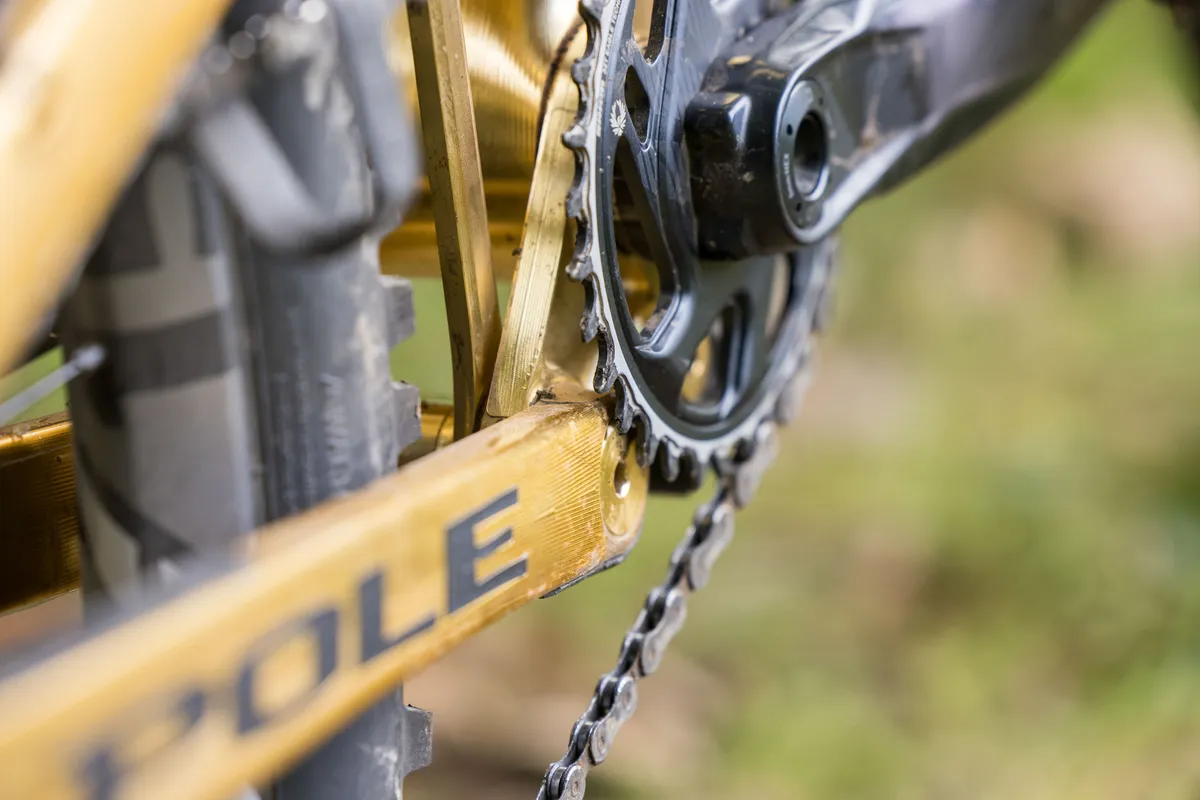
The electrophoretic clear coat finish wasn’t especially even, with the front triangle’s colour being lighter in places and darker in others. The swingarm and front triangle weren’t quite the same colour, either. Towards the end of the test period the finish had begun to rub off where the brake and gear cables had contacted the frame during suspension compression.
There’s also very limited clearance between the chainring and the end of the chainstay and its connecting pivot. Although there is just enough clearance for up to a 36t chainring, the tight tolerances shouldn’t be a problem because generally people use 32t rings. However more importantly, where the chain leaves the chainring and rotates clockwise towards the rear derailleur, it’s incredibly close to the swingarm.
Pole has fitted a stick-on strip of mastic tape to dampen any noise and reduce the chances of the underside of the swingarm being damaged. I can confirm this tape gets well used and does its job of keeping things quiet. More tape could be added to improve the amount of protection on offer. Although in my opinion, the tape is a fix to a problem that’s been unnecessarily created by the layout of the swingarm.
The optional STFU chain damper, that’s zip-tied to the seat stay, further helps reduce chain slap noise and doesn't appear to interfere with the chain’s path.
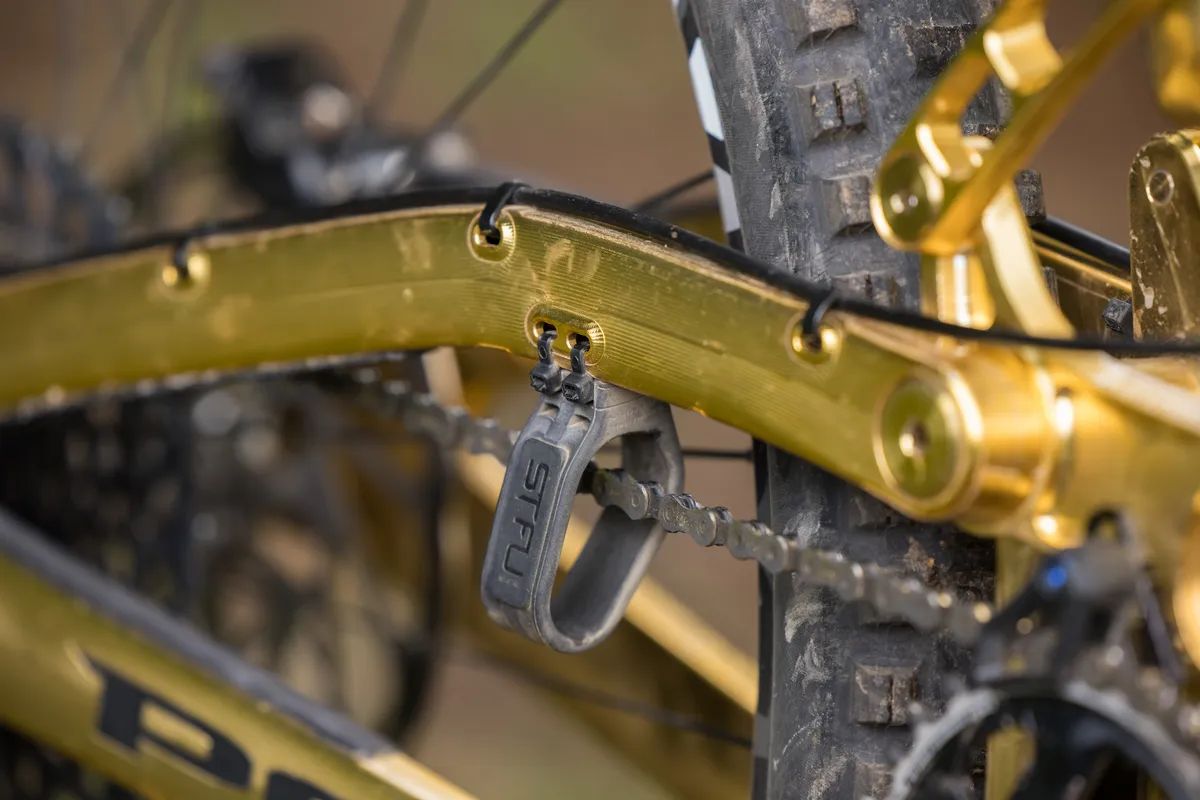
I found the clamping force required to stop the seat post from rotating or slipping down in the seat tube was higher than the 5-6Nm torque setting the seat post clamp is rated for. A sturdier seat post clamp could be a wise investment.
Pole Stamina 160 Remastered bottom line
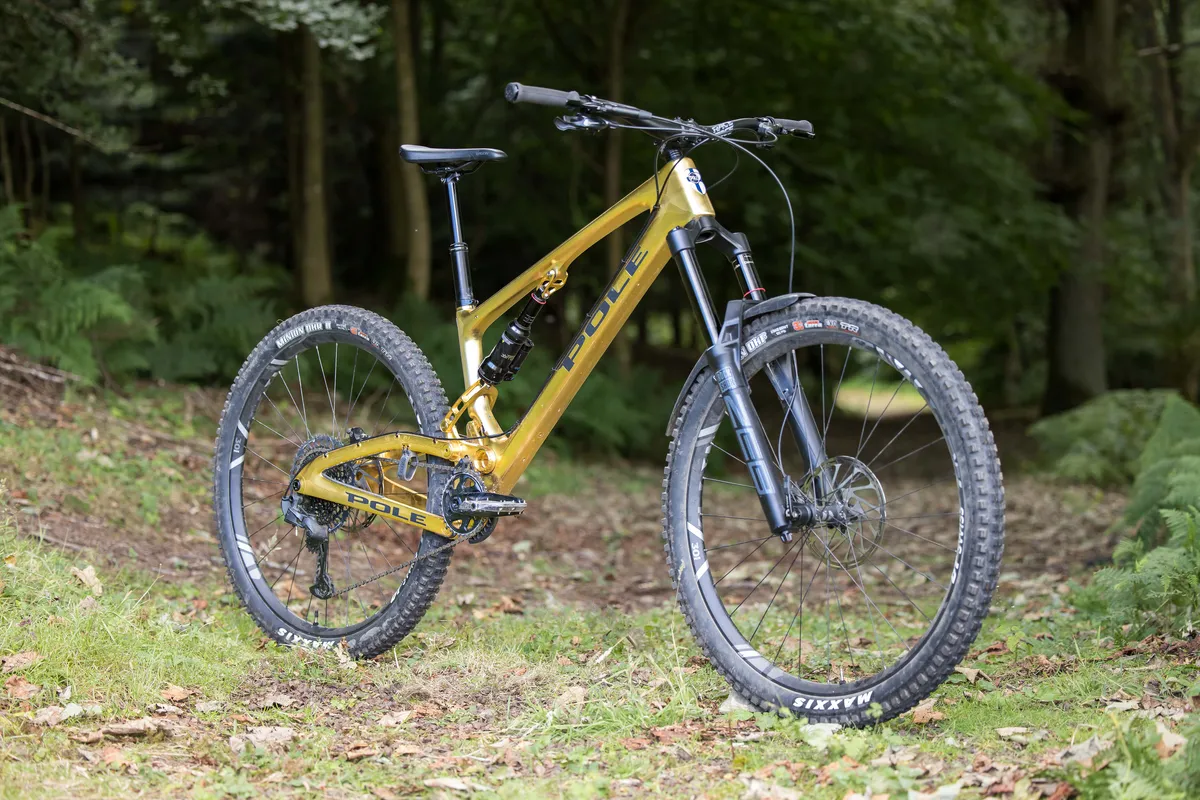
The Stamina 160 Remastered is a unique proposition in every respect – from its unusual construction techniques, incredible aesthetics, and amazingly bright gold colour through to its enduro-ready spec and lofty price tag.
It’s not without its faults and some of the parts on it such as the tyres, in my opinion at least, will need instantly changing out to dramatically improve performance. Its suspension might be too aggressive for some, too, and would probably work better with a coil shock.
I think the Pole is going to suit a few people. Firstly, it’s the hardcore enduro racer who’s after a hard-charging big-hitting bike to ride on big terrain. Next, someone who appreciates the design and construction elements of the bike – there’s been a massive amount of intrigue around the Stamina when I’ve ridden it on my local trails. Finally, your average weekend warrior will also benefit greatly from the relaxed geometry, but they’re most likely to need to carefully set up the suspension and change out some components to get the most from it.
The Pole’s geometry is its biggest draw and, thankfully, its most dominating trait. Not only can it be ridden incredibly quickly over almost any terrain, it does so with total composure and a calmness that’s almost peerless. On the way back up to the trail heads, it’s especially comfortable thanks to the steep seat tube angle.
This is a true racer’s enduro bike that is designed for outright speed, and it delivers on that promise.
Product
| Brand | pole |
| Price | 5604.84 EUR |
| br_whatWeTested | Pole Stamina 160 Remastered Stock Custom |
| Weight | 15.7700, KILOGRAM (K2) - K2, without pedals |
Features
| Fork | RockShox ZEB Select |
| br_stem | Race Face Chester |
| br_chain | SRAM GX Eagle |
| br_frame | Pole Stamina 160 Remastered |
| Tyres | Maxxis Minion DHF 3C MaxxTerra EXO 29x2.5in (f), Maxxis Minion DHR II 3X MaxxTerra EXO 29x2.3in (r) |
| br_brakes | SRAM Code R |
| br_cranks | SRAM GX Eagle DUB |
| br_saddle | Ergon SM10 |
| br_wheels | DT Swiss EX1501 |
| br_headset | Cane Creek 40-series |
| br_shifter | SRAM GX Eagle |
| br_cassette | SRAM GX Eagle (10-52t) |
| br_seatpost | Bikeyoke Revive 125mm |
| br_gripsTape | Race Face Lovehandle |
| br_handlebar | Race Face Chester |
| br_rearShock | RockShox Super Deluxe Ultimate RCT |
| br_bottomBracket | SRAM DUB |
| br_availableSizes | K1, K2, K3, K4 |
| br_rearDerailleur | SRAM GX Eagle |
